Article mis à jour le 28 May 2025
What to do in the north and northeast of Thailand: discovering unmissable and hidden gems
When we think of Thailand, the first images that come to mind are those of its beautiful beaches and paradise islands. The south coast of the country, which attracts more and more tourists every year from all over the world, is a dream for many visitors in search of sun and vibrant landscapes. But did you know that the land of smiles has some incredible nuggets that are still unknown? Here’s what we’re going to see: what to do in northern Thailand?
Before I get into this, let me introduce myself. My name is Brice, I’m 32 years old and I traveled Southeast Asia for a year with my partner. In total, we stayed more than two months in Thailand, during which we lived unforgettable moments, seen splendid landscapes… and guess what? We haven’t set foot in the southern part of the country once!
If, like us, you dream of discovering a different Thailand while traveling differently, then you are in the right place! In this article, I will share my favorites, my good addresses and some tips that I hope will make your next trip to the North and Northeast of Thailand an unforgettable experience!
My itinerary travels through northern and northeastern Thailand
To better understand the article and easily find the sections you are interested in, do not hesitate to use this table of contents to navigate:
North & Northeast Thailand
Before I share my favorite destinations, it is important to understand and differentiate the two regions we are going to talk about. This will allow you to better plan your travel itinerary and understand the specifics of each one.
Because a picture is worth a thousand words, I have prepared two maps to better visualize the whole:
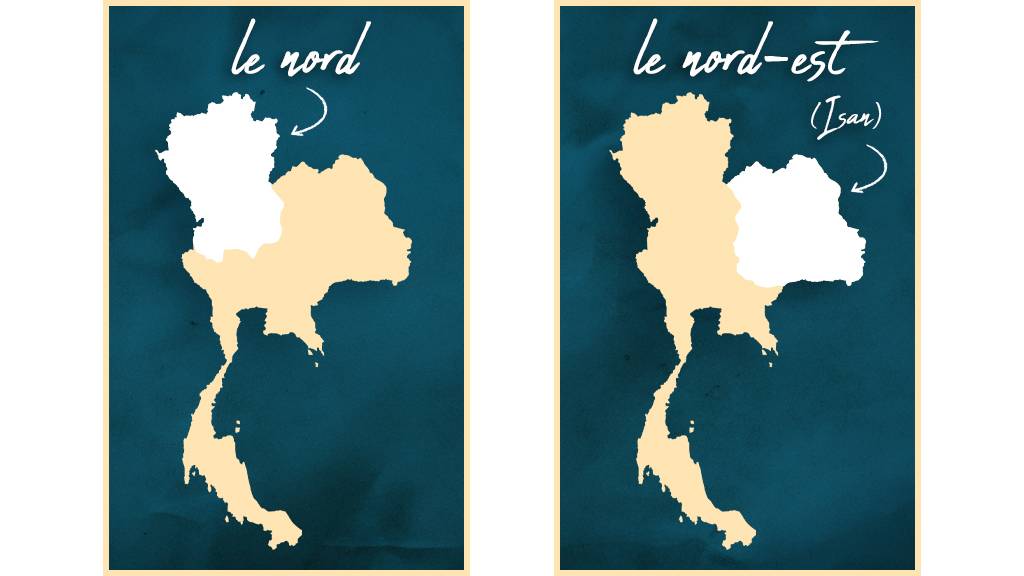
Where to go in Northern Thailand?
So I’m going to start by introducing you why you should go to northern Thailand, an area known for its rich culture, traditional crafts and mountainous landscapes. Then, heading to the North-East, also called Isan, probably the most unknown and least visited part of the country. These two neighbouring regions on the map can easily be combined into a single route, as there are many connections between them. I hope this article will make you want to discover these two beautiful parts of Thailand !
Sukhothai: what to do?
Sukhothai is one of the ancient capitals of Thailand, founded in the thirteenth century during the heyday of the kingdom of Sukhothai. Today, the city is best known for its impressive ruins, listed as a UNESCO World Heritage. Sukhothai is divided into two distinct areas: the Old City with its historic park and remnants of the former royal city (with over 190 ruins of temples and palaces!) and the more modern New City with its shops, markets, restaurants and accommodation.
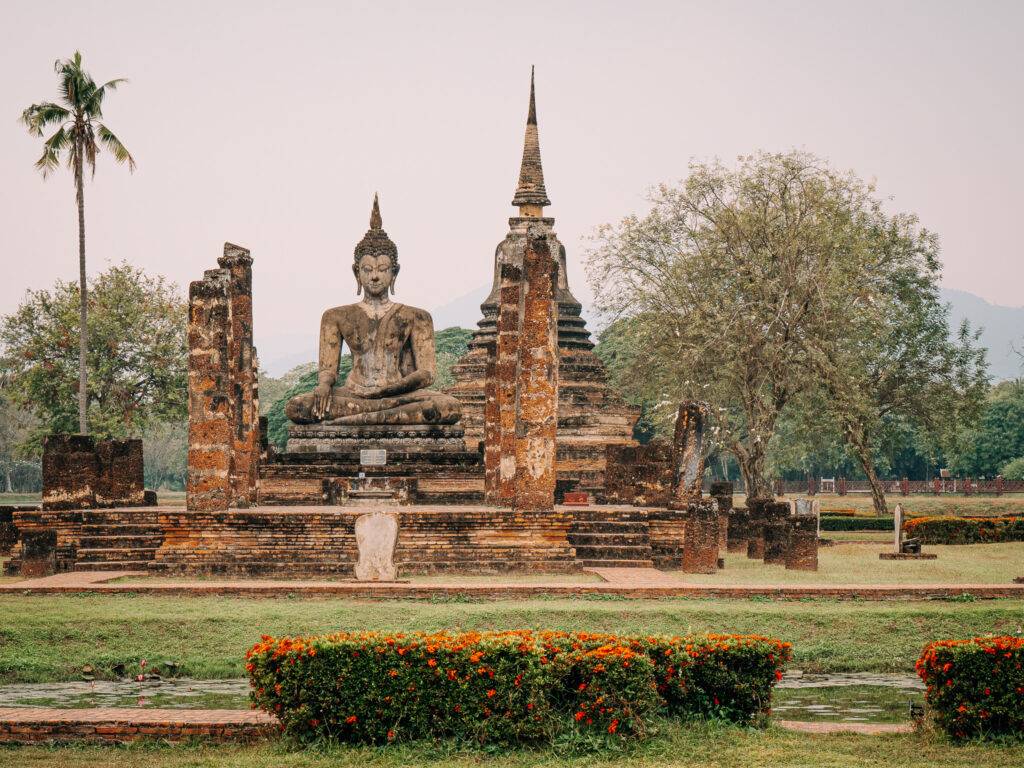
✨ Sukhothai Historical Park
When you visit Sukhothai, the main goal is to discover the historic park of the old town. The entrance to the park costs 100 baht (about € 2.80) per person and area. There are three areas to explore: the central area, the northern area and the western area. In addition to the entrance fee, you will also have to pay a small parking fee if you arrive by vehicle (from 15 to 50 baht depending on the type of vehicle: bike, scooter or cart). Compared to the vastness of the park (70 km 2) and its beauty, the price is largely affordable!
During our stay, we chose to visit only the central area, preferring to walk around and take the time to enjoy the places, rather than wanting to see everything absolutely. As you will discover in this article, we like to travel slowly to fully absorb the places, rather than running around and checking out as many boxes as possible.
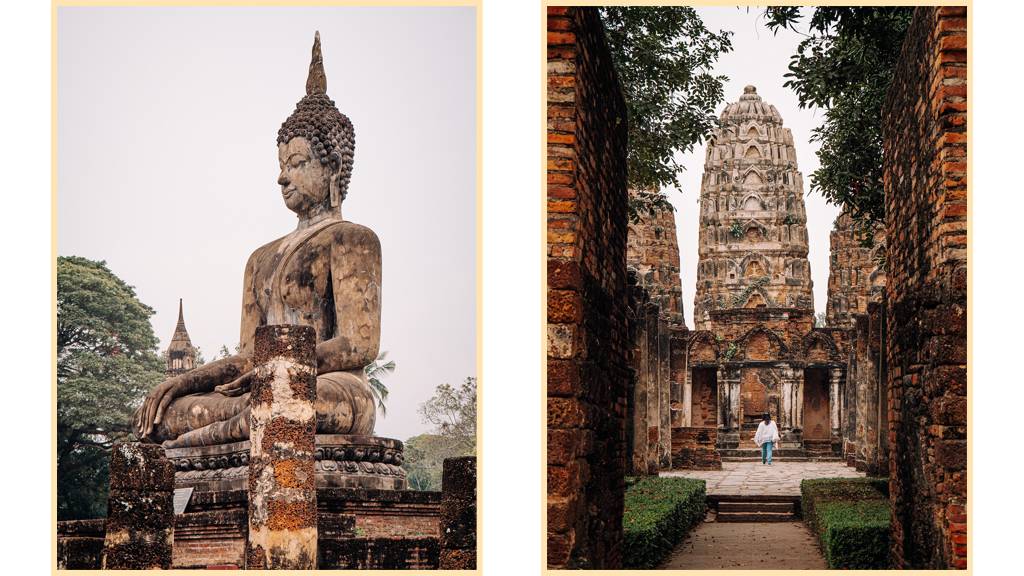
Temples to visit in Sukhothai
I could tell you in detail about the temples of Sukhothai, their history and architecture as the subject is passionate me, but it would be much too long… and I would have trouble shortening! So I will just mention the main buildings to see in the central area (the most visited):
- Wat Mahathat: The largest temple in Sukhothai, the ancient spiritual centre of the kingdom.
- Wat Si Sawai: One of the site’s oldest temples, with Khmer-inspired architecture (present-day Cambodia).
- Wat Traphang Ngoen & Wat Sa Si: Both located on islets in the middle of a pond, particularly photogenic at sunrise or sunset.
- The Royal Palace (Noen Prasat): Located right next to Wat Mahathat. Less well preserved than the others, but its symbolic importance remains strong.
Among these must-see places in northern Thailand, and throughout your walk, you will also have the opportunity to discover many other buildings, perhaps less known, but equally fascinating. The exploration is very pleasant since the site is very well maintained, whether you are cycling or walking. It is a very pleasant place to drive in the shade of tall trees, among wooded areas and ponds dotted with lotus!
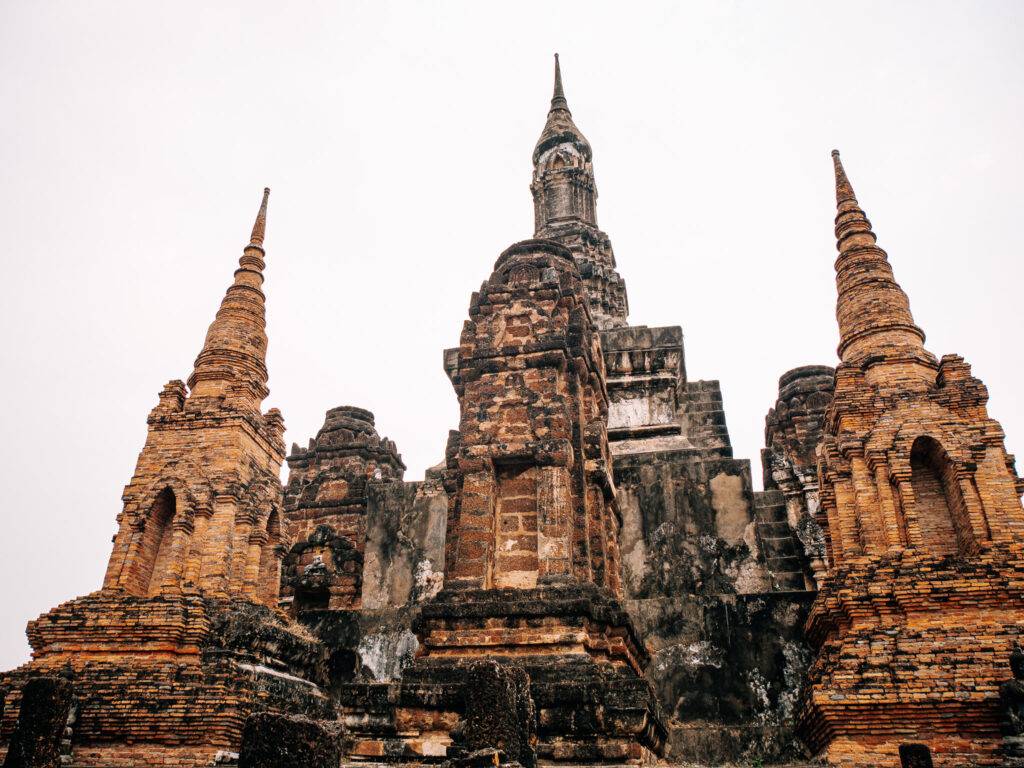
Where to sleep and eat in Sukhothai?
To stay in Sukhothai, a question often comes up: old town or new town?
Honestly, there is no wrong answer: the two parts are quite close and easily accessible from each other. For our part, we have chosen to stay in the new city, where accommodations are often a little more affordable. It is then very simple to reach the historic park, either by local bus (remember to check the schedules), or by Tuk-Tuk, there are a multitude of them and the race usually costs between 50 and 100 baht. We stayed at TR Guesthouse: the room was comfortable, spacious and modern, and the staff, of a remarkable kindness. All for a very affordable price, we highly recommend!
There is also plenty of food to choose from in both parts of the city. Difficult to test, but here are some recommendations:
- Chopper Bar (Old Town): Great location, low price, very good pad thai!
- Jay Hae Sukhothai Noodles (New Town): Very good local noodle soup, family restaurant.
- Café Thammada (Old Town): To drink a delicious coffee right in front of the historic park!
For the rest, we often nibbled right and left on the street food stands of the city, and it was always very good (like everywhere in the country)!
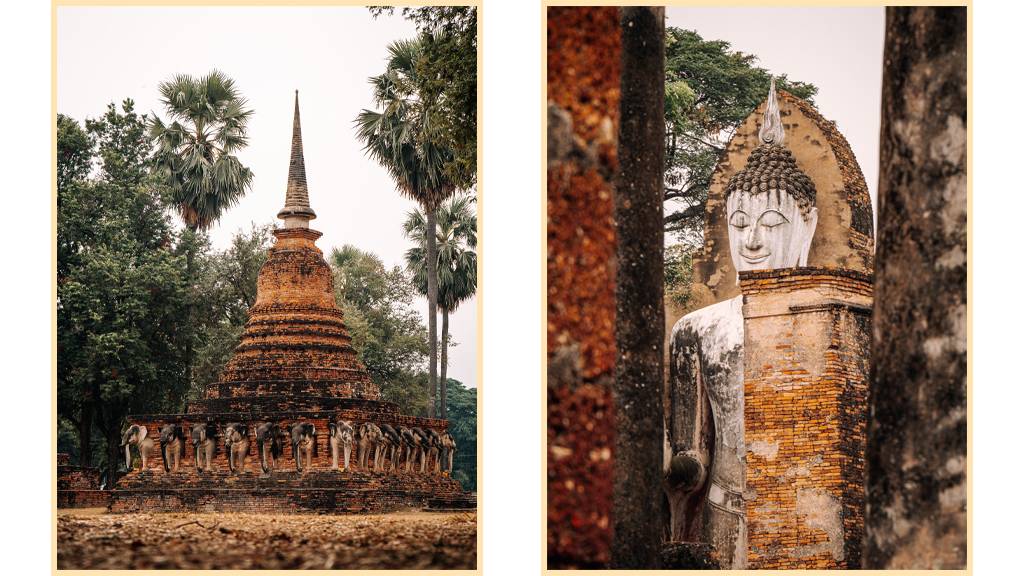
How to get to Sukhothai from Bangkok?
There are several ways to get to Sukhothai:
- By bus: Departures throughout the day from Mo Chit bus station. Expect about 7 to 8 hours of comfortable air-conditioned bus travel. Asia 12go ticket booking.
- By train: Less convenient, but doable. Take the train to Phitsanulok (nearest station), then a minivan or bus to Sukhothai. It’s longer and often more expensive than a direct bus ride, but the train in Thailand is an experience to try at least once!
- In private transport or taxi: This is the most expensive, but also the most comfortable and direct solution. Many agencies or private drivers offer this service in Bangkok.
There are also direct flights from Bangkok, but the road routes are very well developed, so it is better to avoid flying if not necessary. From other destinations, further north or more south, there are a multitude of buses and minivans that will make the connection every day and at any time!
Chiang Mai: the must-see in northern Thailand
Temples abound in Thailand! But if there is a city that embodies the spirituality of the country through its monuments, it is undoubtedly Chiang Mai. You’ve probably heard her name before, maybe even added her to your Northern Thailand travel itinerary. It is indeed a must of the country of smiles! (I promised you lesser known nuggets, patience… they will come very soon!).
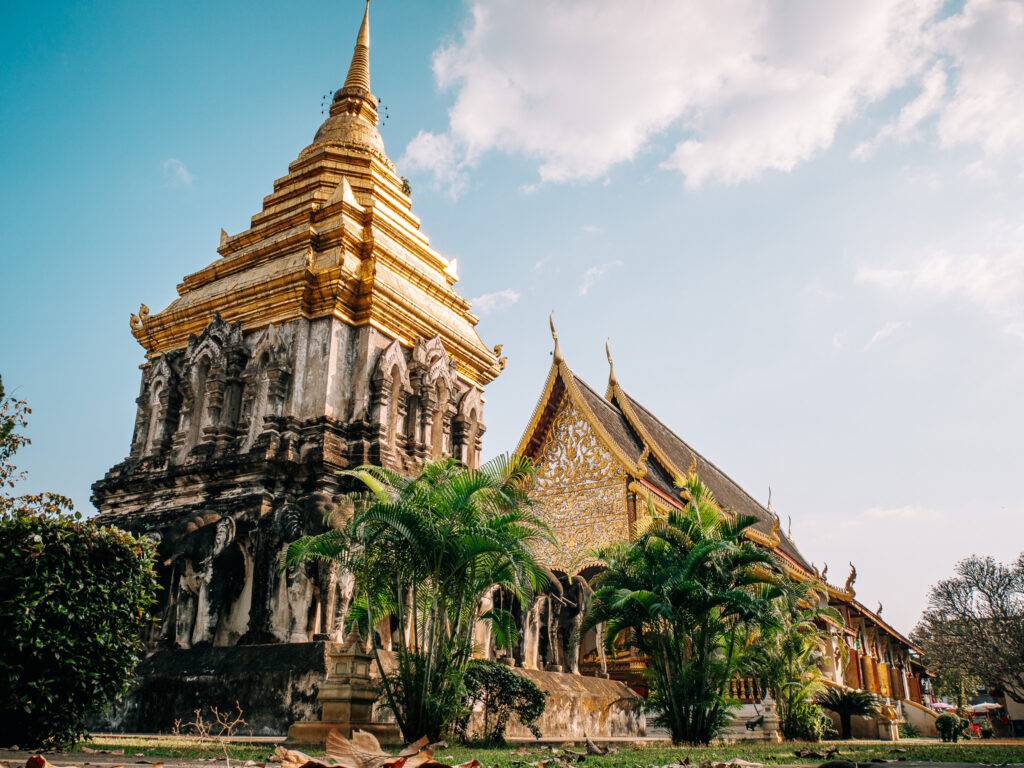
When you visit Chiang Mai for the first time, with more than 300 temples on the clock, you literally don’t know where to go! Of course, the city is also full of other activities, but being passionate about Buddhism and spirituality in Southeast Asia, it was especially in the temples that concentrated our stay. Let me introduce you to some of the ones we loved visiting:
The most beautiful temples in Chiang Mai
Wat Sri Suphan (The Silver Temple)
This is probably one of the most fascinating temples in Chiang Mai. Completely covered in an aluminum alloy finely chiseled by the artisans of the region, it literally shines under the sun!
The carefully hand-engraved details illustrate, as is often the case, Buddhist scenes. But when you look at it more closely, you can see some hints of pop culture: Yoda, comic book characters… enough unusual, and finally not so rare in Thailand! If you are lucky, you may even see the blacksmiths, keepers of a traditional know-how unique to the region, in the temple district.
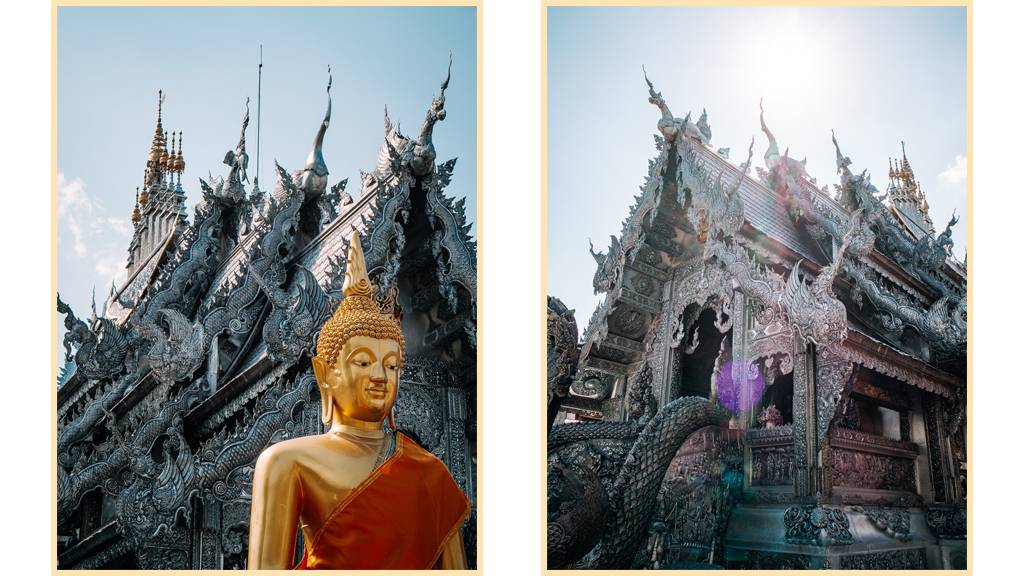
Wat Phra That Doi Suthep
You go a little further away from the centre to climb the hill that you can see from almost everywhere in the city. Up there is one of the most visited Buddhist complexes in the region! To get there, nothing more simple: everywhere in Chiang Mai you will see songthaew, these big red vans, mi tuk-tuk, mi collective taxi, which offer round trips at reasonable prices throughout the day.
Access to the site costs 30 baht (about €0.80). There are several magnificent temples and monuments, including a large golden stupa, very sacred in the region, which is said to house a relic of the Buddha. This place is often frequented by both Thai and tourists, thanks to its spiritual side, ideal for meditation, but also for its breathtaking view of the city below.
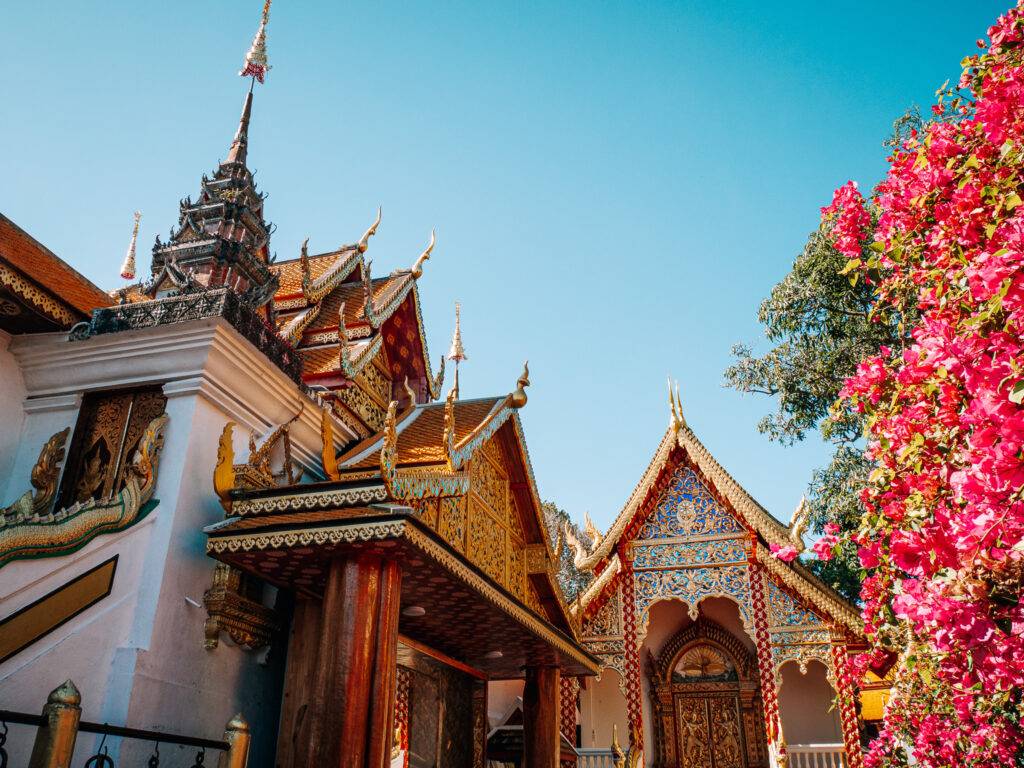
Wat Jetlin
Less known than its predecessors, this complex of temples was nevertheless a real favorite for us! In the middle of the pagodas, we discover a small park with a picturesque pond, crossed by a wooden bridge. Difficult to explain, but this place really touched us. Located south-east of the old town of Chiang Mai, a little away from the tourist bustle, as soon as you enter the compound, you feel like you are suddenly transported to another time!
As everywhere in Thailand and the Buddhist countries, do not forget to respect places and spiritual codes: cover your shoulders (avoid tank tops), your legs (no shorts) and remove your shoes as well as hats or caps when you enter a temple.
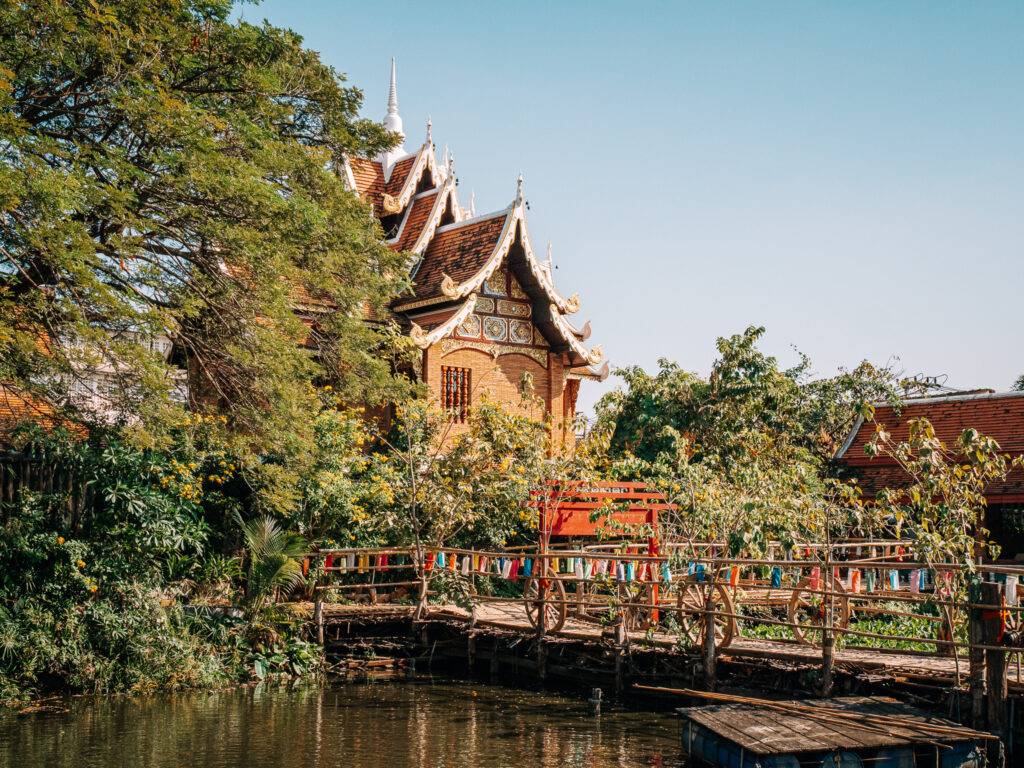
Wat Chedi Luang
Probably the most famous temple in the old quarter of Chiang Mai, Wat Chedi Luang is famous for the ruins of its huge 60 meter high brick stupa. It once housed a sacred relic, the Emerald Buddha, now carefully preserved in Bangkok.
The entrance to the complex costs 50 baht (about 1,40€). In addition to the large stupa, you can admire other pagodas that surround the site, as well as magnificent traditional wooden houses. Wat Chedi Luang is also located near the Night Market of Chiang Mai on Rachadamnoen Road. In my opinion, it is a must-see night market, especially if you like local crafts!
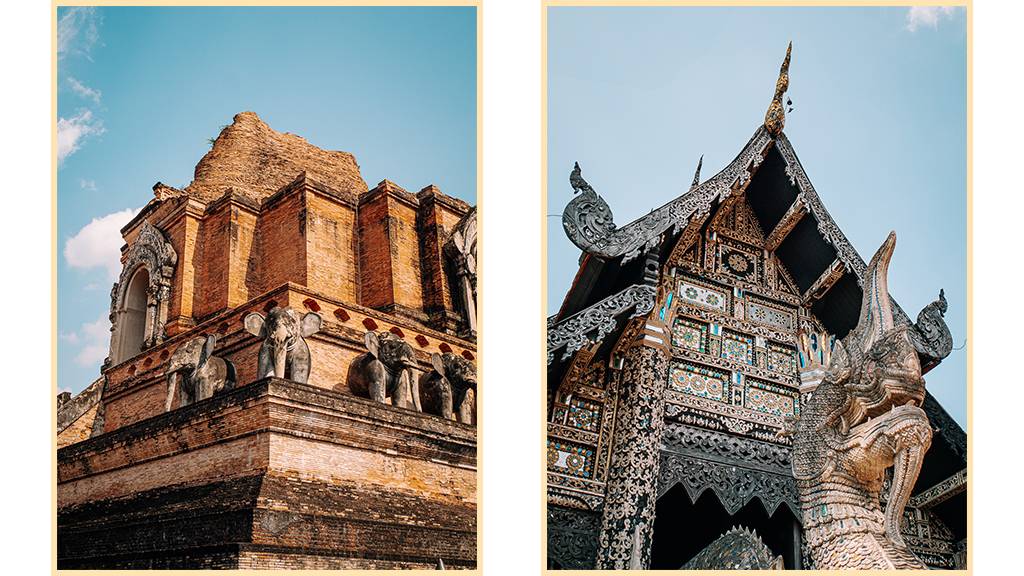
Where to sleep and eat in Chiang Mai?
In Chiang Mai, the choice of accommodation is so vast that it’s hard to find one! Whatever your budget or your expectations, you will find your happiness. If I had to recommend a place with great value for money and an ideal location, it would be Little Guest House. A very comfortable, clean and especially close to a small night market (where we ate every day) and a 7-Eleven for your last minute needs! By crossing the road and a bridge, you will be directly in the old town.
No worries for eating in Chiang Mai. The city is a culinary paradise with its cuisine rich in flavors, including the famous Khao Soi, emblematic dish of the region. For our part, we mainly ate on the night markets of the city, either the one in the center or the one near our guesthouse. Sincerely, you will find restaurants in every street, it is a treat for the taste buds! Special mention to the Mr. Kai Restaurant, which offers an impressive range of Thai and Southeast Asian dishes with fresh produce at truly unbeatable prices!
How to get between Bangkok and Chiang Mai?
The city is a high tourist destination in Thailand, it is easily accessible from almost all major cities of the country, with daily departures and at all hours.
- By bus: Regular departures are available from nearby cities or even Bangkok (from the Mo Chit bus station) at all times of the day. The ride is comfortable, but it can take several hours depending on the distance. Book your tickets online on 12go Asia!
- By train: From Bangkok, it takes around 12 to 14 hours to get there, but if you’re coming from other nearby cities, the journey time is much shorter. The journey from the capital is relatively long, but it offers beautiful scenery and you can easily book a sleeper train for more comfort.
- ✈️ By plane: Although I don’t necessarily recommend flying, it can be a good option if you have a short stay in Thailand. The flight from Bangkok to Chiang Mai takes approximately 1h15, and you will take off from Don Mueang Airport, where several daily flights are available.
Northern Thailand Route: Chiang Rai Stop
Last stop before diving into the lesser-known Thailand, heading for Chiang Rai and its surroundings. We stay on the theme of temples, and believe me, those who discover them have nothing to envy to those already mentioned!
One of our favourite means of transport in Asia is undoubtedly the scooter. At almost every stage, we rented one so that we could walk freely and at our own pace. Some of the temples mentioned below are a bit out of the city center, but don’t worry: if you’re not comfortable on two wheels, there are many other options on site, from tuk-tuk to taxi or even collective taxi!
What to do in Chiang Rai?
Wat Rong Khun (White temple)
Without a doubt one of the most iconic temples in the country. It must be said that when you set foot in the complex for the first time, it is difficult to remain indifferent to such beauty!
Beyond being an important place of worship, the Temple Blanc is a true work of contemporary art. And you will see, it is not the only one in this style in the region! It was born from the imagination of a Thai artist named Chalermchai Kositpipat and, as you may have guessed… it is completely white! Entrance to the complex costs 20 baht per person (about 0.50 €). And if you are curious about this gentleman’s work, a museum next door will allow you to better understand his approach and vision. It is clearly one of the most photogenic temples in Asia!
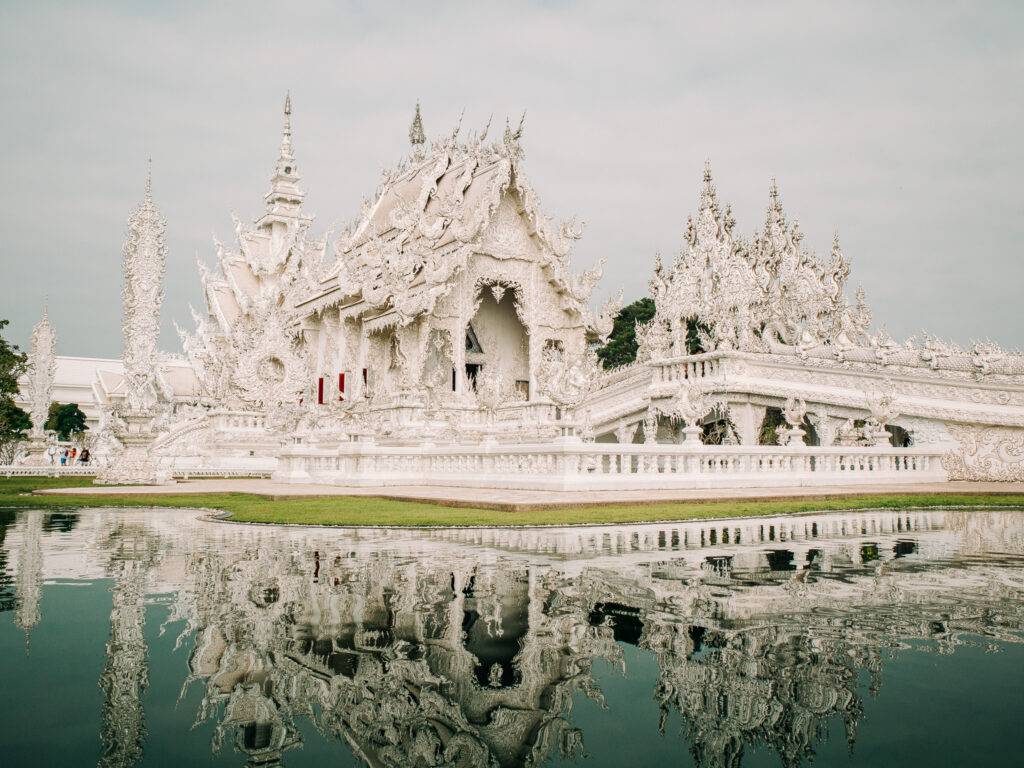
Wat Rong Suea Ten (Blue temple)
Change color from white to blue! Always imagined by the artist I mentioned above, the Blue Temple is, in my opinion, a must-see during a trip to Chiang Rai. Like the White Temple, it is part of this new wave of contemporary temples in Thailand, and it is mainly covered… of blue, enhanced with beautiful gilding. There are also many mythological statues, always in the same artistic universe. This time, the entrance is free, so no excuse not to go for a walk!
Beyond being an important place of worship, the Temple Blanc is a true work of contemporary art. And you will see, it is not the only one in this style in the region! It was born from the imagination of a Thai artist named Chalermchai Kositpipat and, as you may have guessed… it is completely white! Entrance to the complex costs 20 baht per person (about 0.50 €). And if you are curious about this gentleman’s work, a museum next door will allow you to better understand his approach and vision. It is clearly one of the most photogenic temples in Asia!

Wat Rong Suea Ten (Blue temple)
Change color from white to blue! Always imagined by the artist I mentioned above, the Blue Temple is, in my opinion, a must-see during a trip to Chiang Rai. Like the White Temple, it is part of this new wave of contemporary temples in Thailand, and it is mainly covered… of blue, enhanced with beautiful gilding. There are also many mythological statues, always in the same artistic universe. This time, the entrance is free, so no excuse not to go for a walk!
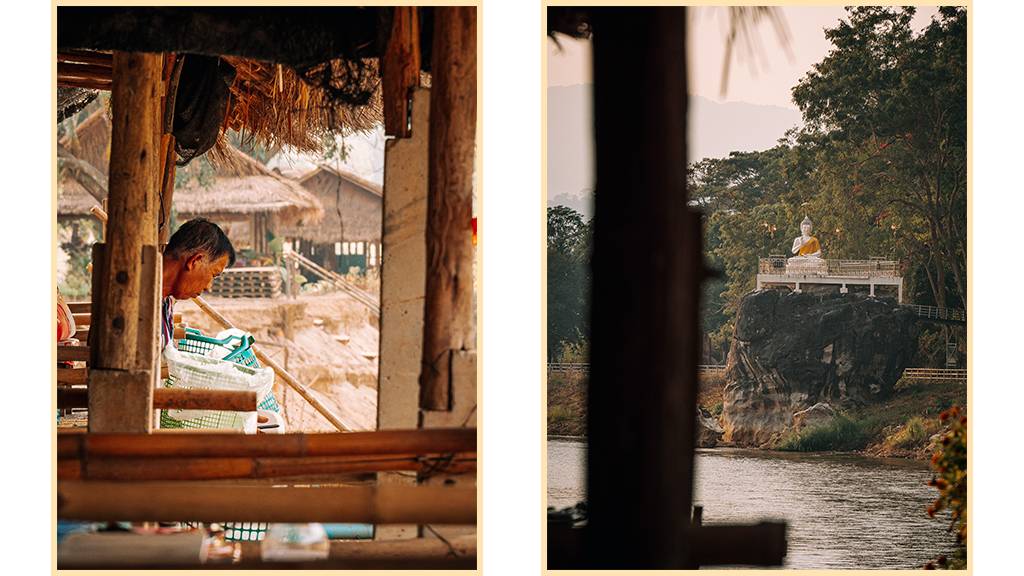
Where to sleep and eat in Chiang Rai?
For accommodation in Chiang Rai, there are plenty of options for all levels of comfort. On our side, we chose the guesthouse as Jansupar Court and we don’t really regret it. Admittedly, the place is a little out of the way, but being on scooter, this did not pose us a problem. The managers, very welcoming, helped us well for the rental of a two-wheeler!
Regarding food, no worries, the offer is so varied. Here are some addresses that we tested:
- Boonsita Vegetarian Restaurant: A small canteen on the roadside that, at first glance, doesn’t pay off, but as often in Southeast Asia, it’s a good sign! The prices are super affordable and the food, all vegetarian, is absolutely delicious. We talked about it throughout our trip!
- Barrab Restaurant: A little more expensive than the small “canteens” of the city, but the quality of the food is excellent, with a wide choice of dishes for all tastes! And as a bonus, it was right next to our guesthouse.
- Dear Friends Bistro: If you want to take a break from Thai cuisine and get some western flavours, this restaurant is the place!
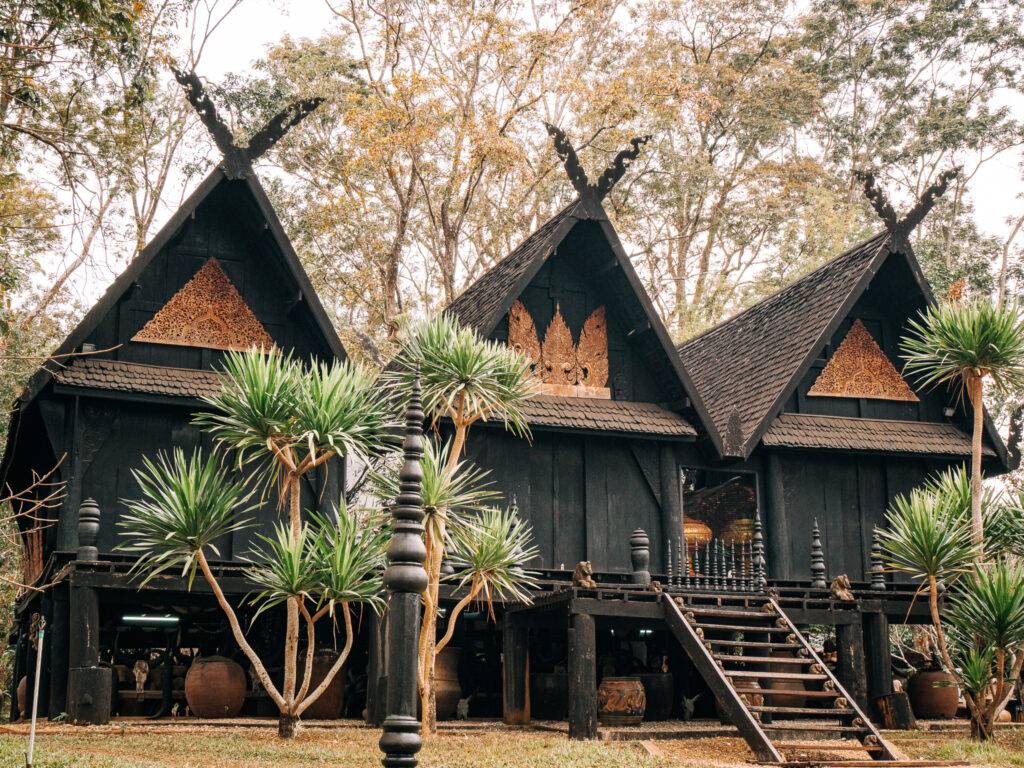
How to get to Chiang Rai from Bangkok?
Chiang Rai is located almost in the far north of Thailand, so here’s how to get there:
- By bus: Chiang Rai is very well served by long distance bus lines. From Bangkok, the trip takes about 12 hours. It is recommended to book your tickets in advance on 12go Asia, especially during busy periods. From Chiang Mai, the bus ride takes about 3.5 hours.
- ✈️ By plane: The city has an airport located approximately 8 km from the city centre. Daily flights from Bangkok to Chiang Rai, with a flight time of approximately 1h30. From the airport, you can get to the city centre using the small shuttle bus for about 20 baht.
Visiting Northern Thailand: stop in Lampang
After reaching the far north of the country with Chiang Rai, we slowly begin our descent towards the northeast. Let’s take a look at less touristy destinations in Thailand, which I’m really looking forward to sharing with you!
But before that, a little stop on the road to tell you about Lampang, a city that was our first real crush in Thailand. We had no special expectations before staying there, it was just a step before continuing our route to the east, but… waow, what a surprise!
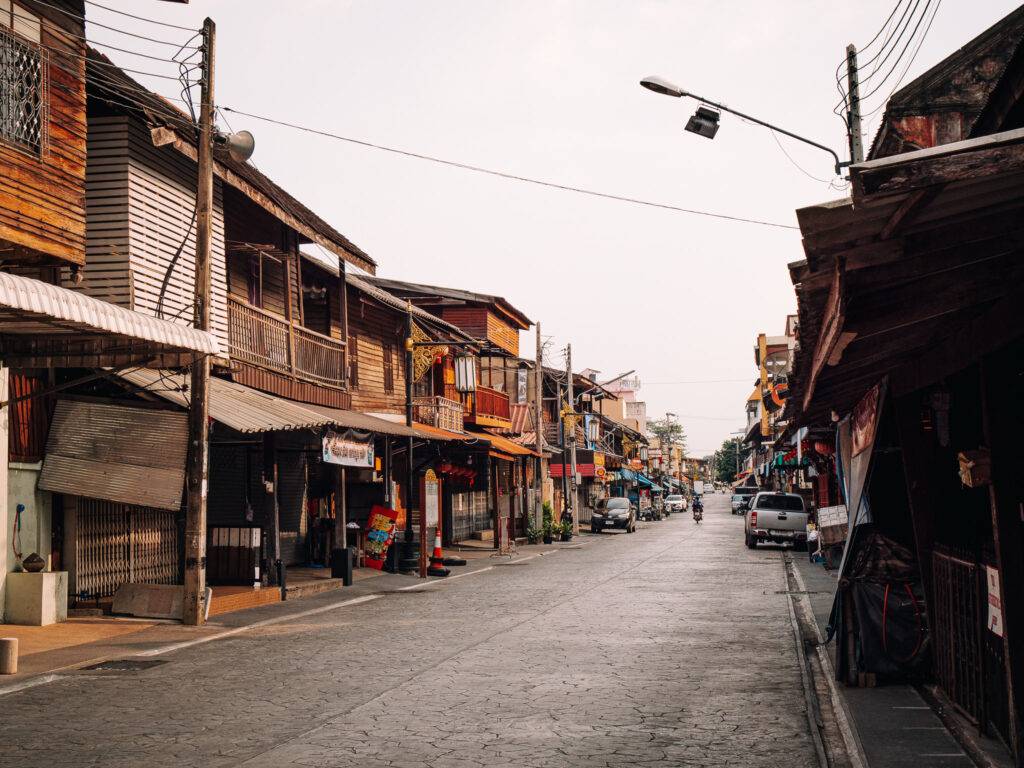
What to do in Lampang?
Lampang is a city where few tourists choose to stop. And yet, it is full of charm and things to discover! For starters, the Night Market is simply amazing. It takes place in the evening on Talad Gao Road, the main artery of the city, lined with beautiful traditional wooden houses: it’s beautiful. The two nights we went there, there was a lot of people (only locals), but the atmosphere was great: very quiet, almost silent, while the street was black with people! A friendly and respectful atmosphere… we loved it.
Wat Koh Walukaram
One of the big advantages in Lampang is that you can easily discover the city on foot. There is little traffic in general, and it’s really nice, especially along the Wang River. So we put on our sandals and walked around the city for two days. And on the first day, we stumbled upon (by chance) a temple that caught our eye: Wat Koh Walukaram.
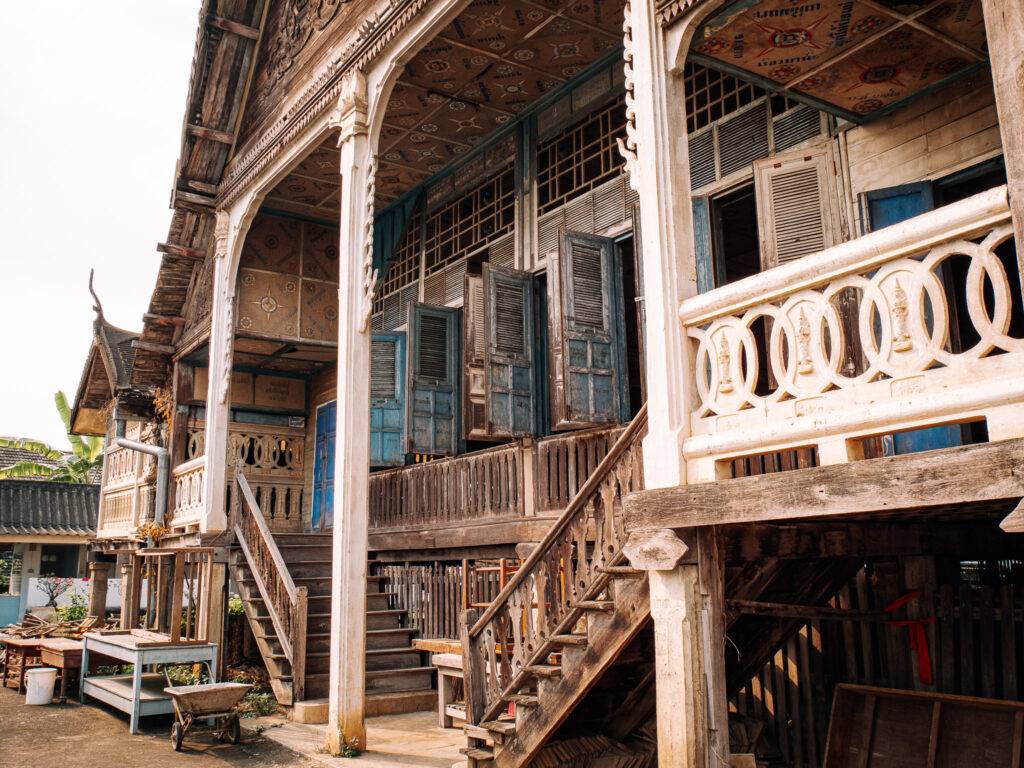
The complex, as often in Buddhist sites, is composed of several pagodas. What intrigued us immediately was the main building, entirely made of wood. A monk who passed by kindly allowed us to enter, and the interior was simply beautiful. Far from the abundant gilding that is often found in Thai temples, here everything was sober, almost raw: from the frame to the prayer altars. It really felt like going back in time, the place seemed frozen in another era. If you go through it, you will quickly notice that its architecture stands out. And for a reason: it is strongly influenced by the Burmese style. It must be said that Lampang and its region have a strong historical link with Burma. I won’t go into details here, but believe me, it’s exciting.

✨ Moung Ngwe Zin Building
Another must-see in Lampang is the Moung Ngwe Zin Building and Talad Gao Road. If you are visiting the city, take the time to walk along this street. It is lined with beautiful traditional Thai houses, full of charm. And at its heart, you can’t miss the Moung Ngwe Zin Building, a building that catches your eye when you pass by.
This is an old colonial wooden building, very well preserved, in the heart of Talad Gao Road. With its white facade and touches of Burmese influence, it contrasts directly in the middle of traditional Thai houses. Originally a shop owned by a wealthy Burmese merchant, it still retains its original charm. Frankly, it’s like a postcard stuck in time.
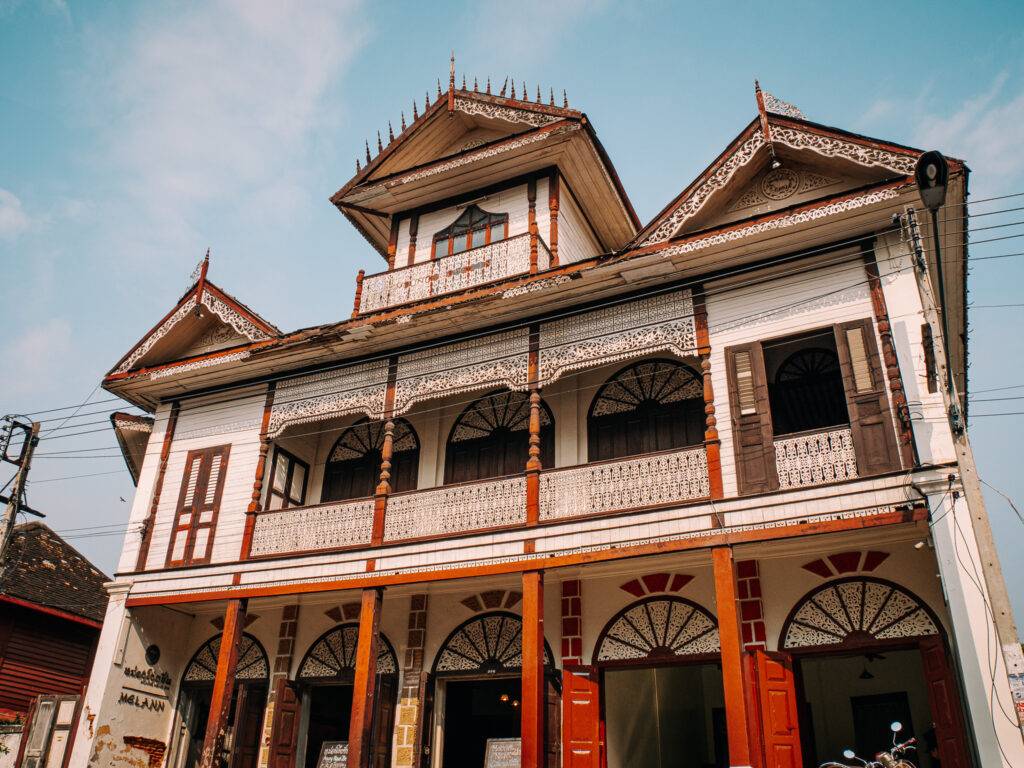
✨ Sankul Thai Massage
There are thousands (millions?) of massage parlours in Thailand! Like many travelers, I had the opportunity to test several during our road trip. That may not be the kind of recommendation you would expect to find in an article like this…. but I can’t help telling you about it. This show really made an impression on me and I still think about it regularly today!
For the record, I have big back problems that appeared two months before the start (no luck). I tested a lot of stuff: drugs, various methods, massages… nothing really worked. The Thai massage is renowned, but it depends on the salon and especially the person who massages you, the quality can be very uneven. I came into this room completely by chance, and from the moment I got there, I knew it was different. You are asked to fill out a questionnaire about your pain, your history, then a doctor examines you briefly before assigning you a masseur or a masseuse adapted (e). The massages were intense, painful (traditional Thai massage requires), but incredibly targeted. We feel that here, we are dealing with real pros of the human body, not just wellness masseurs. After two days, my pain had decreased by at least 50%, and this effect lasted for several months. I did my best to return during our one-year trip to Asia, but the route did not allow it. If I had known, I would have stayed in Lampang two weeks just for that!
(Of course, each case is different; always seek advice from a healthcare professional before starting this type of treatment, especially if you have a serious illness.)
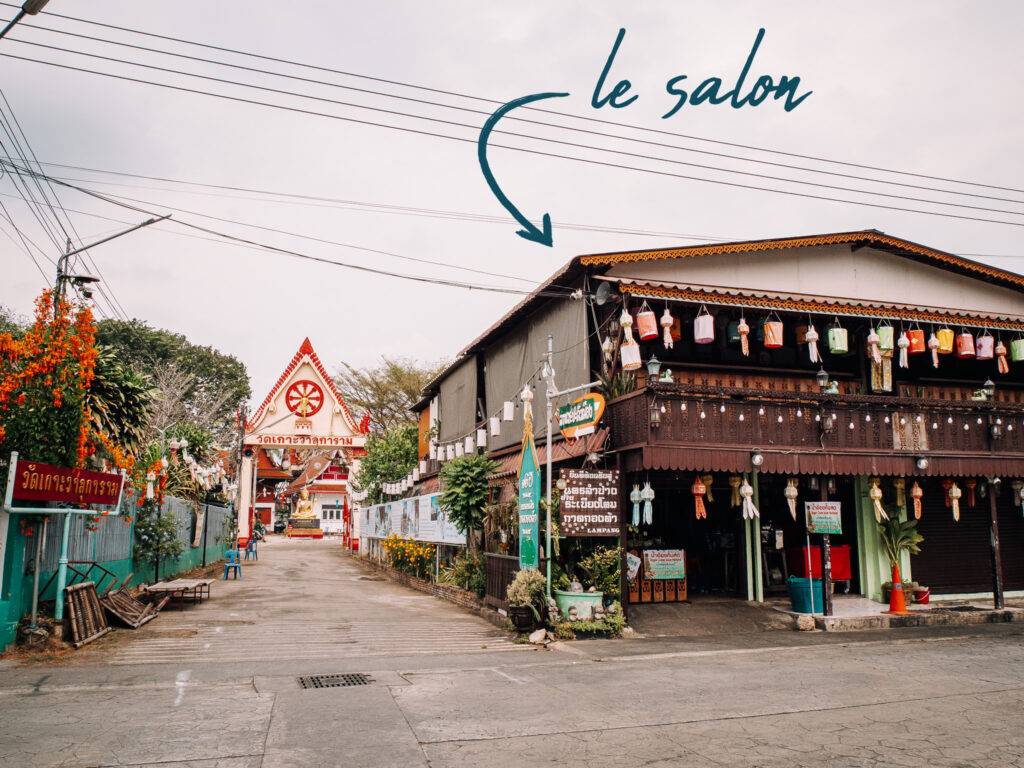
Where to sleep and eat in Lampang?
Even if Lampang is not the most touristic city in the country, there are still a lot of choices when it comes to accommodation. Big hit for the Huglampang Boutique Hotel. It is ideally located in the city center, close to the main street. The rooms are super comfortable and the staff is really caring. A real gem, and probably one of our favourite Travel to the North of Thailand accommodations.
For restaurants, here are some recommendations:
- The Riverside Restaurant Lampang: Ideally located by the river, this place offers delicious cuisine and a very pleasant setting.
- Aroy one baht: A very popular restaurant among locals (always a good sign), with very affordable prices and tasty dishes.
- The Night Market: As I said earlier, the Lampang night market is really great! We ate there every night, and the prices were always very affordable. In addition, there was a huge choice, whether for salty or sweet!
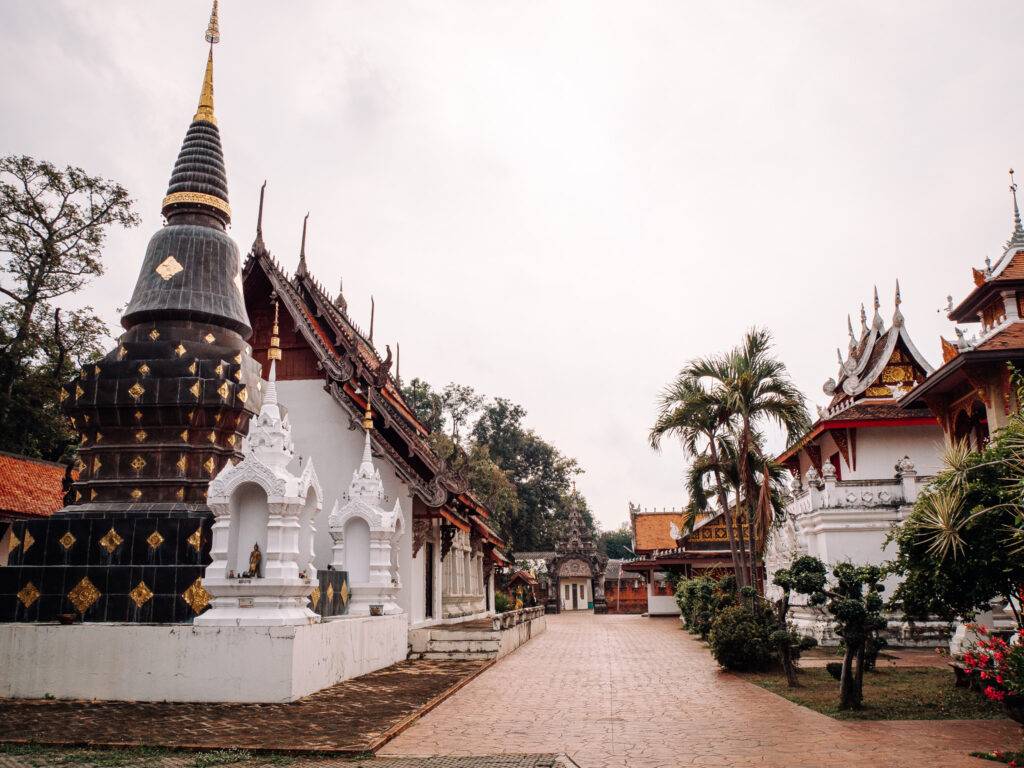
How to get to Lampang?
- By bus: From Chiang Rai we took the bus to Lampang. The trip took about 5 hours and cost us 7€ per person. From Bangkok, there are also connections from the Mo Chit bus station, with a journey time of approximately 8:30.
- By train: Departures are available all day from Bangkok for a journey between 8.30 and 11.30, depending on the type of train you choose. Book your tickets online
What to do in Northeast Thailand?
Chiang Khan
This new destination is without a doubt one of our biggest favourites in our year of travelling to Asia. Chiang Khan is a small town with village charm, ideally located on the mythical Mekong River, in the northeastern region of Thailand, more commonly known as Isan. Sometimes there are places that touch us by their aura so special, difficult to describe, but you must discover to appreciate the full flavor… Chiang Khan is one of them!
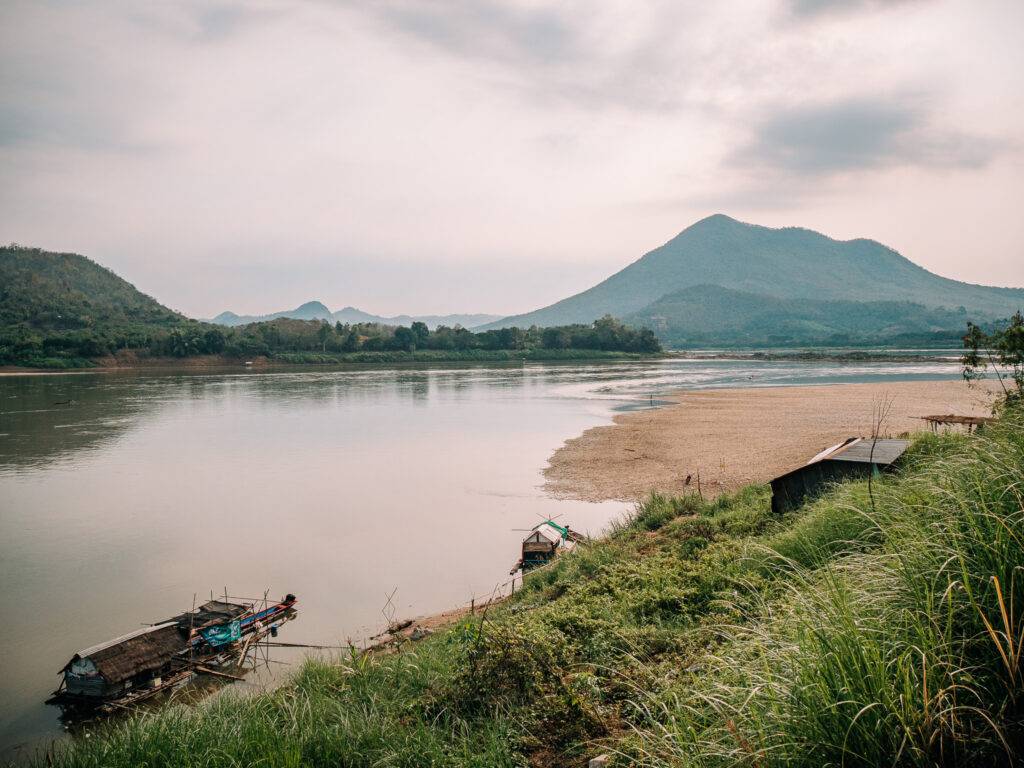
What to visit in Chiang Khan?
Chiang Khan is a little visited place by tourists, but quite popular with Thai. The latter like to come on weekends and during holidays to enjoy the calm and special atmosphere. The city is located on the banks of the Mekong and on the other side of the river, you will have the opportunity to see Laos during your stay!
Bike ride along the Mekong
This may be our favorite activity in the region: a bike ride along the Mekong!
A very well maintained bike path connects Chiang Khan to the small village of Noi, located about 7 km away. Beyond the special atmosphere that offers the Mekong, the walk will take you through small typical villages and discover the charming surroundings of the region. A taste of Laos!
➡️ If Laos is on your bucket list, find the 10-day itinerary in Laos written by Yann.
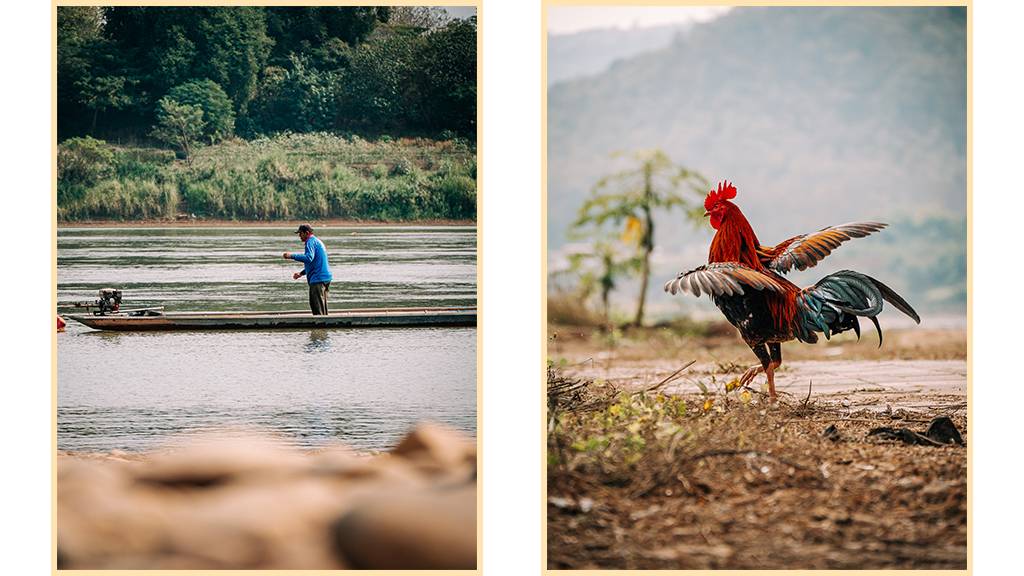
You can easily find several places in Chiang Khan to rent bikes. On our side, our housing has even lent them to us free of charge, I tell you about it in the article.
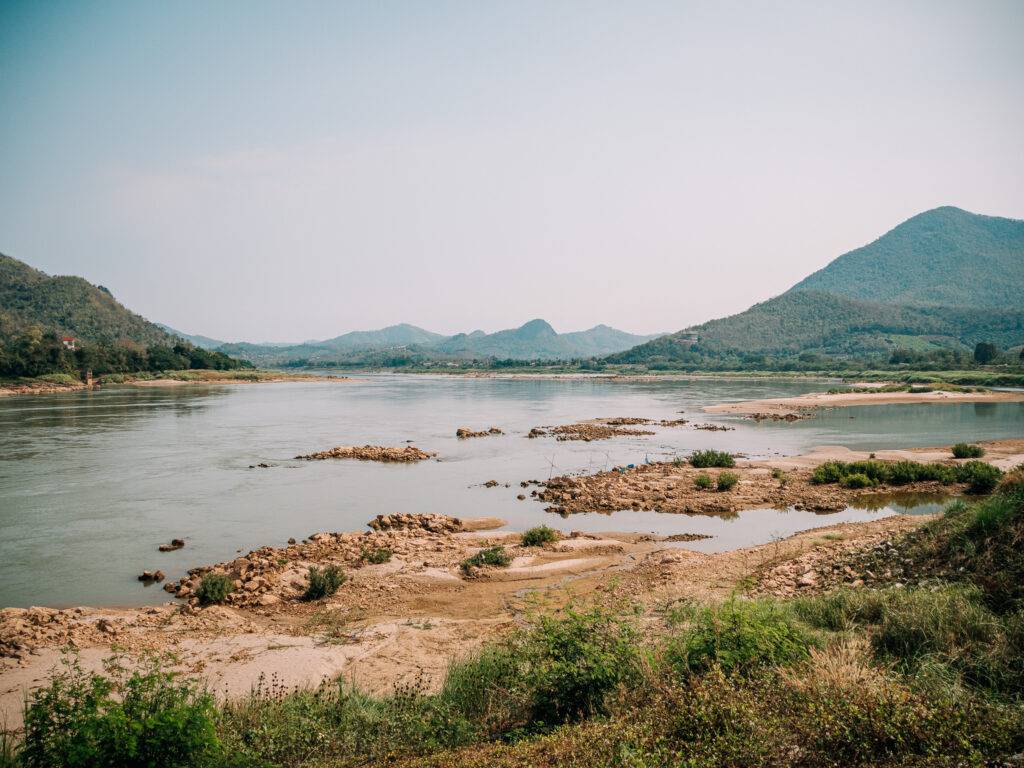
Once you arrive in Noi, you will find several food and drink vendors to take a break in a really peaceful and beautiful setting with always Laos as a backdrop. And if you’re lucky, there are sometimes even some dance and music animations near the most famous viewpoints.
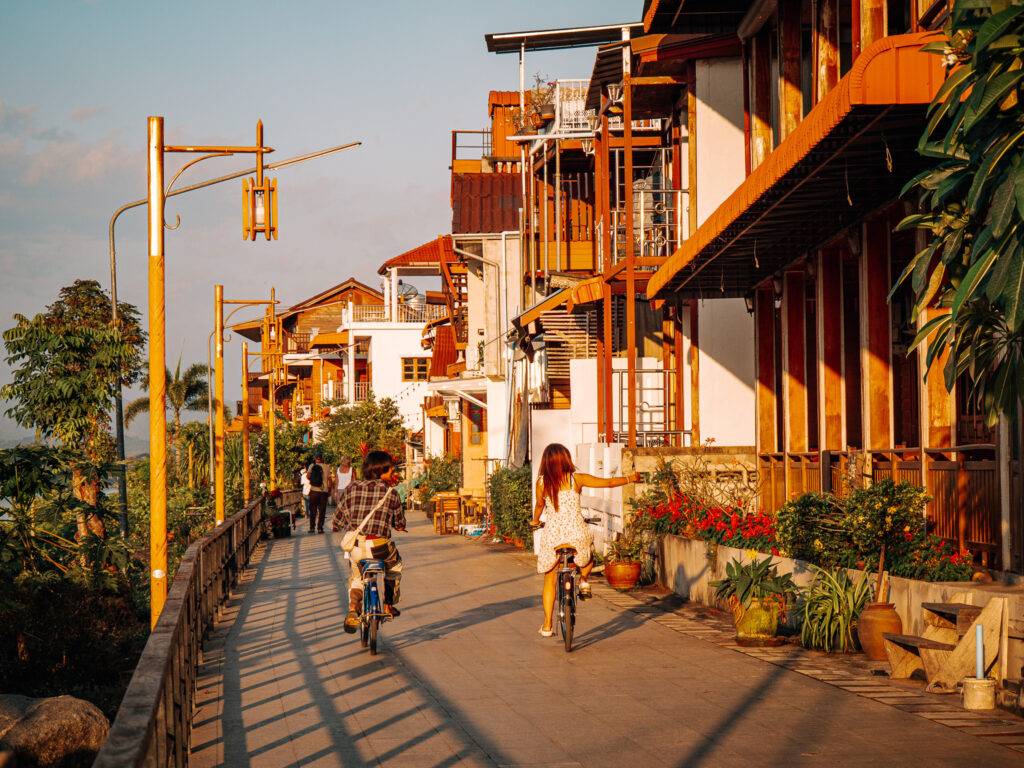
✨ Chiang Khan’s Night Market
Another night market that will make your taste buds thrill! I haven’t told you yet, but what makes Chiang Khan so special is its city center, lined with traditional Thai wooden houses, a bit like in Lampang. The night market takes place every evening, from 16h to 22h (and it is even more lively on weekends). It is full of stands of all kinds: sweet, salty, souvenirs, crafts, clothes…
This is again a must-see market if you are visiting the area.
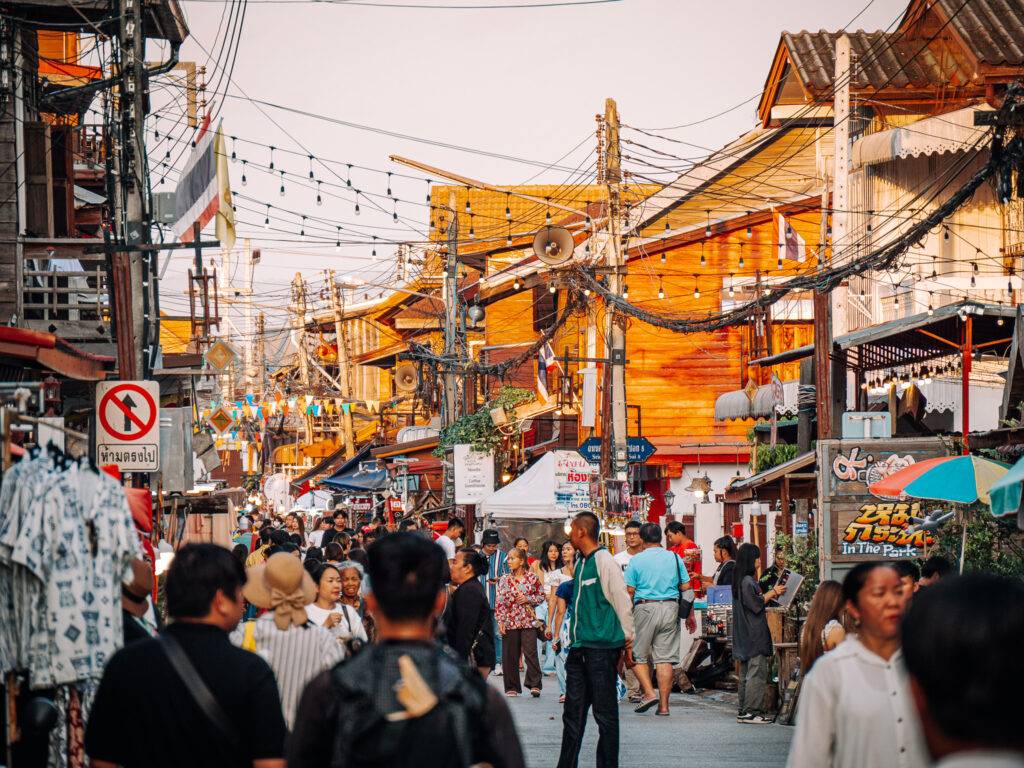
Always in a very friendly and warm atmosphere, if you are there, like us, during the school holidays in Thailand, you will see a crowd of locals rush there! Even if sometimes we like to be alone in the places we visit, we love when the markets are crowded, it gives rise to memorable scenes of life! When the sun goes down, take a few steps to face the Mekong and do not miss the beautiful sunset that inflames the river.
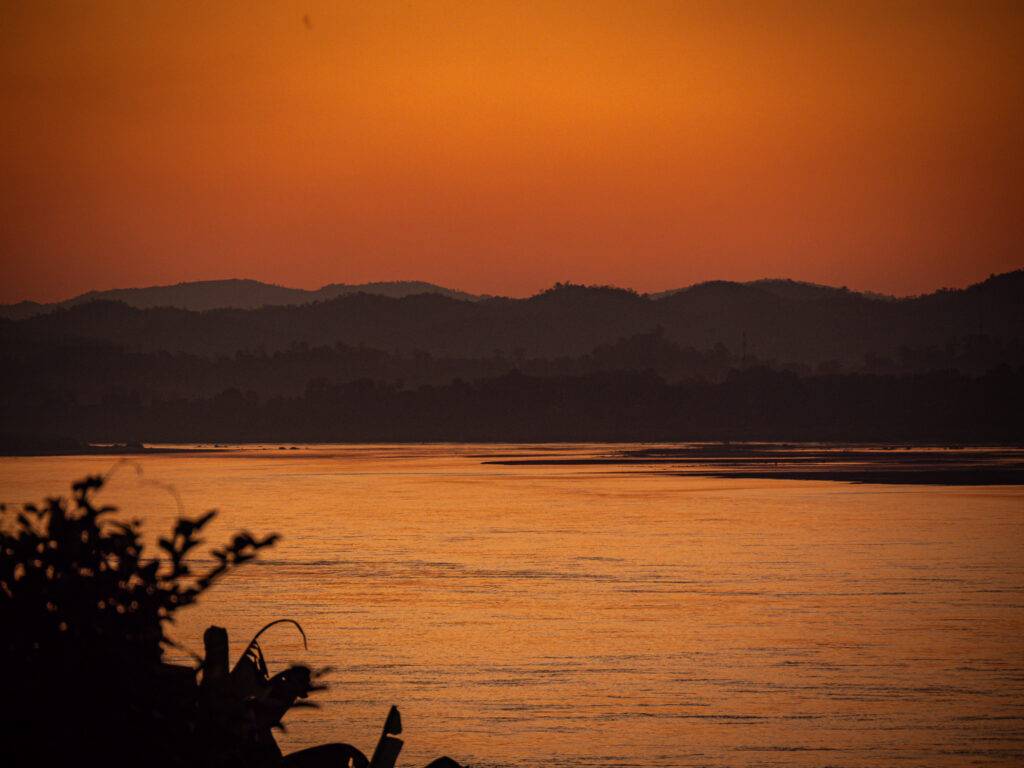
Wat Phra Puttabat Phu Kwai Ngoen
We ride our scooter again, direction one of the most emblematic temples in the Isan region, located about 13 km from the city. After climbing a hill (a little difficult on a scooter, it must be admitted), we find ourselves immersed in a truly singular Buddhist complex. Beyond the main pagoda, very beautiful, which houses a huge footprint of Buddha and the splendid view over the entire region, what makes the place so unique is… her rabbit park!
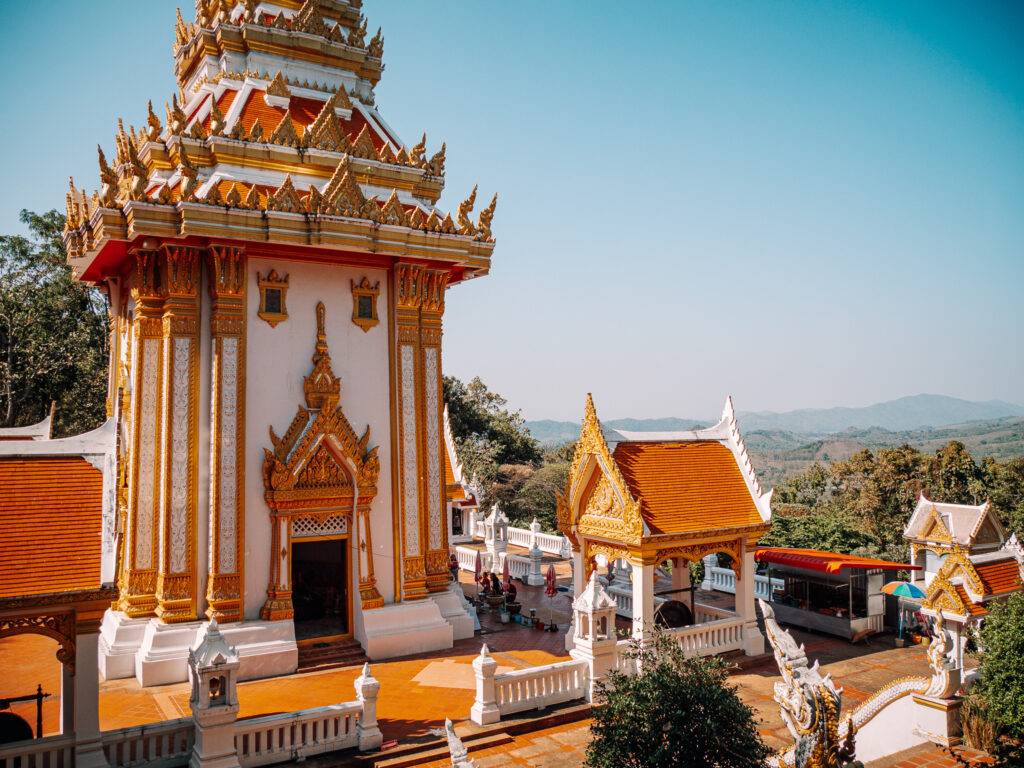
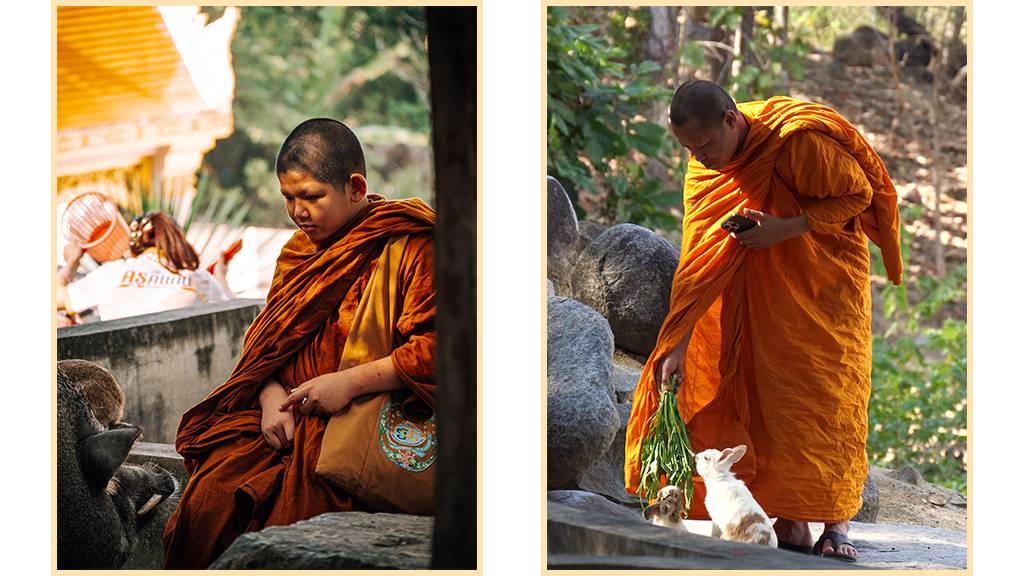
The site houses a kind of reserve with dozens or even hundreds of rabbits! Unusual, isn’t it? You can even, for a few baht, buy food and feed them yourself.One would almost forget that we are in a sacred place… but the monks, who also feed the animals, offer magical scenes that gently remind us of the special aura of the place.

Where to sleep and eat in Chiang Khan?
I have a great accommodation recommendation if you want to stay in Chiang Khan. We have rarely been so well received by our hosts as here; the manager and her husband are people of rare kindness. The property offers a few rooms in an old traditional wooden house, really comfortable! The breakfast is also amazing, prepared to measure by the boss, according to your desires. The establishment is called “Chiangkhanburi Loei”, but for find it on Booking, it is written in Thai: เชียงคานบุรี.
To eat in the city, beyond the night market in the evening, there are plenty of small restaurants along the Mekong, here are some places you liked:
- Smile @ChiangKhan: Great setting, beautiful view and delicious food.
- Heon LuangPrabang: Laotian cuisine, a little more expensive but cooked with care.
How to get to Chiang Khan?
Travelling in the Isan can sometimes be a little complicated if you have not prepared your route upstream. The destinations are all accessible but the region is less touristy, so it can sometimes be a little more risky.
- By car or taxi: If you have rented a car, it is not a problem to reach Chiang Khan, the roads in Thailand are generally in very good condition. Likewise, if you take a taxi or private transport, everything will go smoothly. Depending on your previous step, these two options may be the most comfortable and simple.
- By bus/public transport: For our part, we were leaving from the town of Phitsanulok, not far from Sukhothai. We took a night bus to reach Loei, the largest city in the Chiang Khan region, after about 5 hours of driving. Then, we borrowed a Songthaew, a large collective tuk-tuk, for 2 hours to reach our final destination. There is little reliable information available online regarding bus schedules and crossings, but if you have any doubts, do not hesitate to go directly to the nearest bus station: Thai people are generally very welcoming and will be happy to help you!
➡️ Book your transport on 12go Asia
What to do in North East Thailand in the Isan?
Highlights of Nong Khai and the surrounding area
Nong Khai is a large city located north of the Isan, known for its proximity to Vientiane, the capital of Laos. A friendship bridge connects the two cities: you can cross the border here if it is part of your itinerary. It is especially the activities around that are really worth a visit, more than the city itself, even if it remains rather nice!
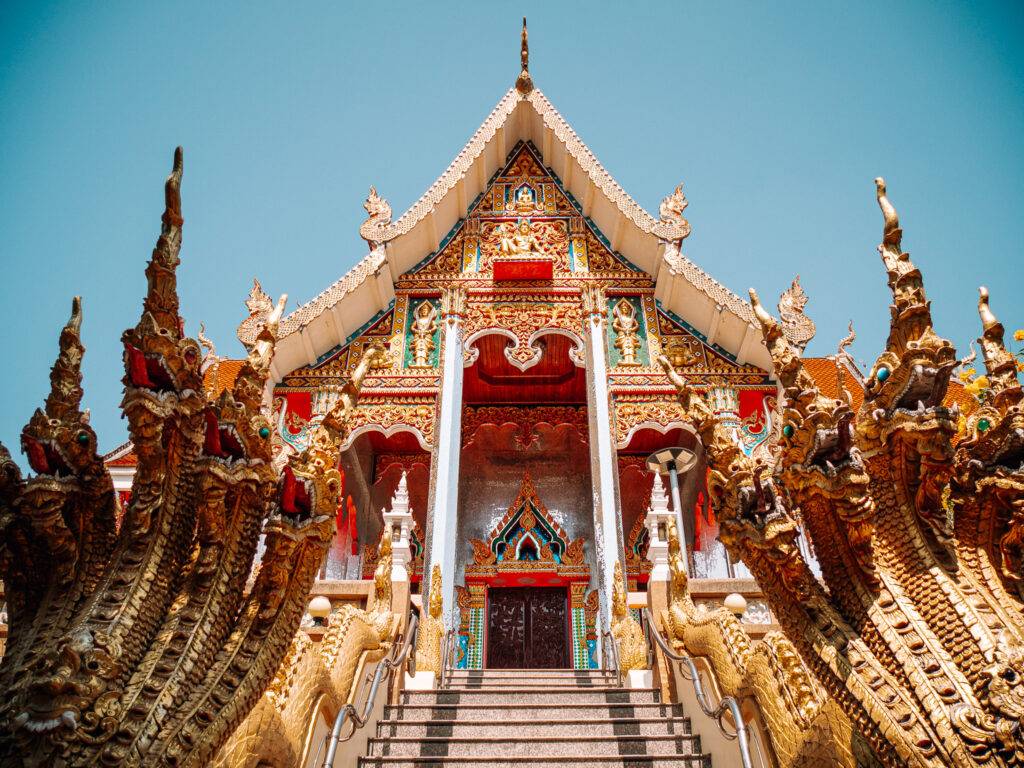
Phu Phra Bat Historical Park
Just over an hour’s drive from Nong Khai, the Phu Phra Bat Historical Park is a place you might not expect when planning to visit Thailand. Imagine a natural park filled with gigantic rock formations, carved by erosion for millions of years, among which there are traces of prehistoric life: paintings, shelters and remains of human dwellings dating back several millennia!
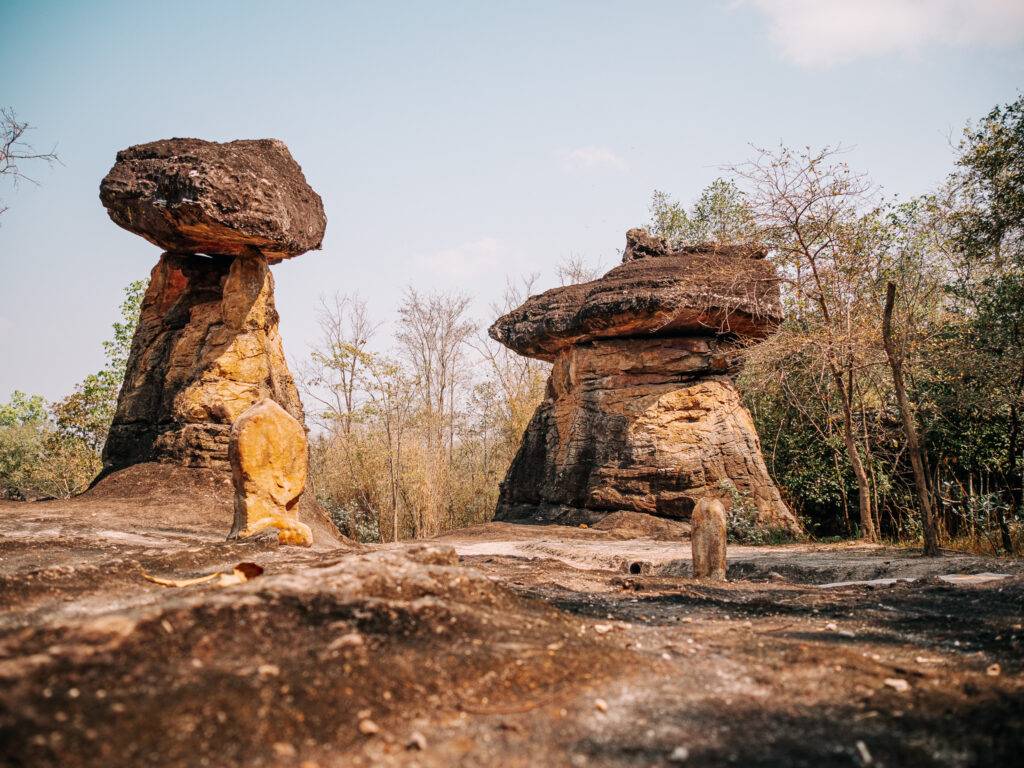
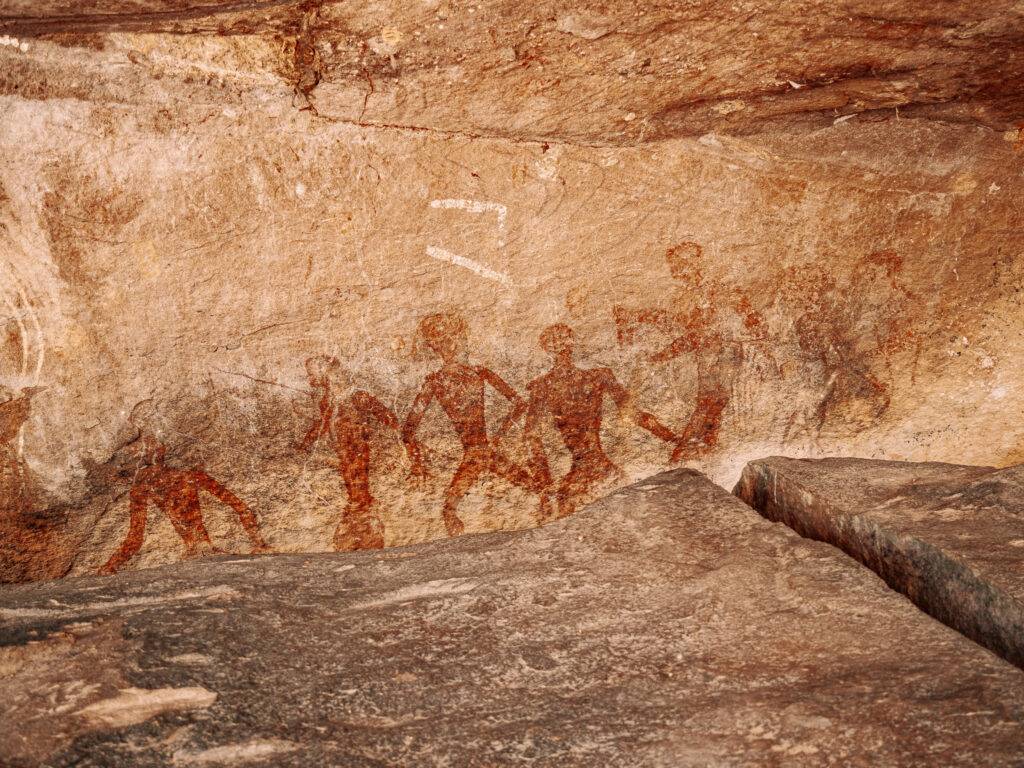
Later, the site was also used as a place of Buddhist worship, with small shrines scattered everywhere. It’s peaceful, mystical, and really fascinating, perfect for a captivating walk. Admission to the park costs 100 baht per person (about 2.80 €). Plan a good half-day tour, or even a full day if you like to take your time.
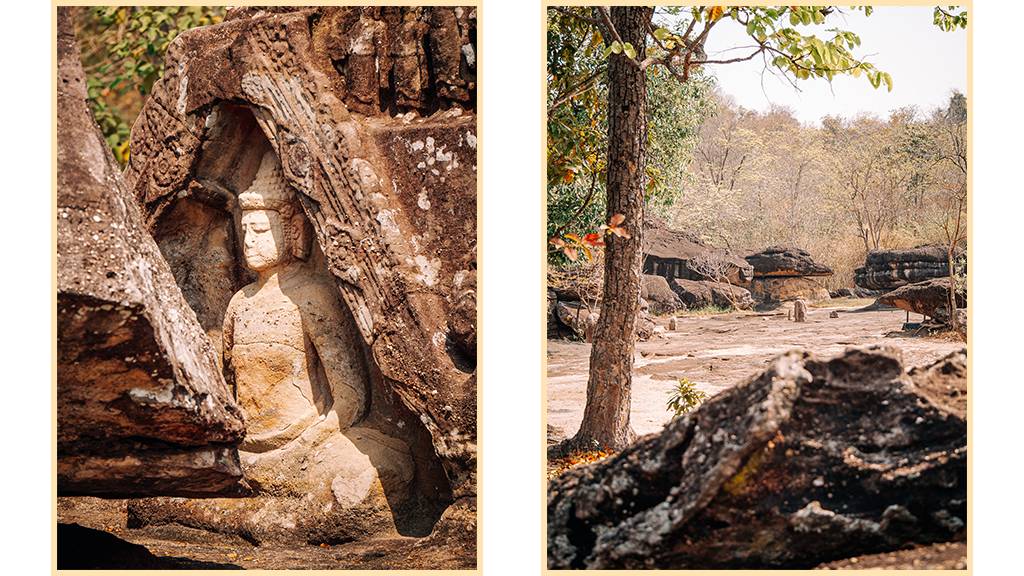
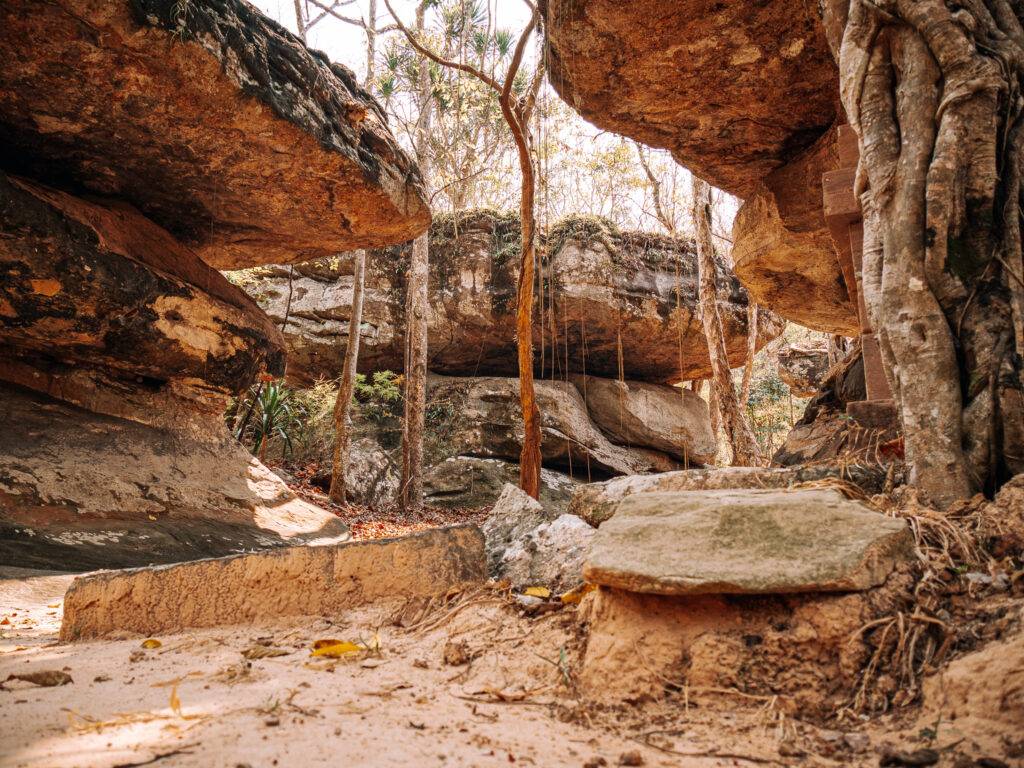
Boat tour on Wang Bua Daeng Lake
Slightly southwest of Nong Khai is a large, lotus-covered lake called the Wang Bua Daeng. If you are in the area, do not hesitate to meet the Thai posted at the entrance: they offer boat rides on the lake for 200 baht for two people (about 5.50 €). The outing lasts about an hour and, in the morning, it’s really nice. As a bonus, you will be able to see several species of birds during the ride.
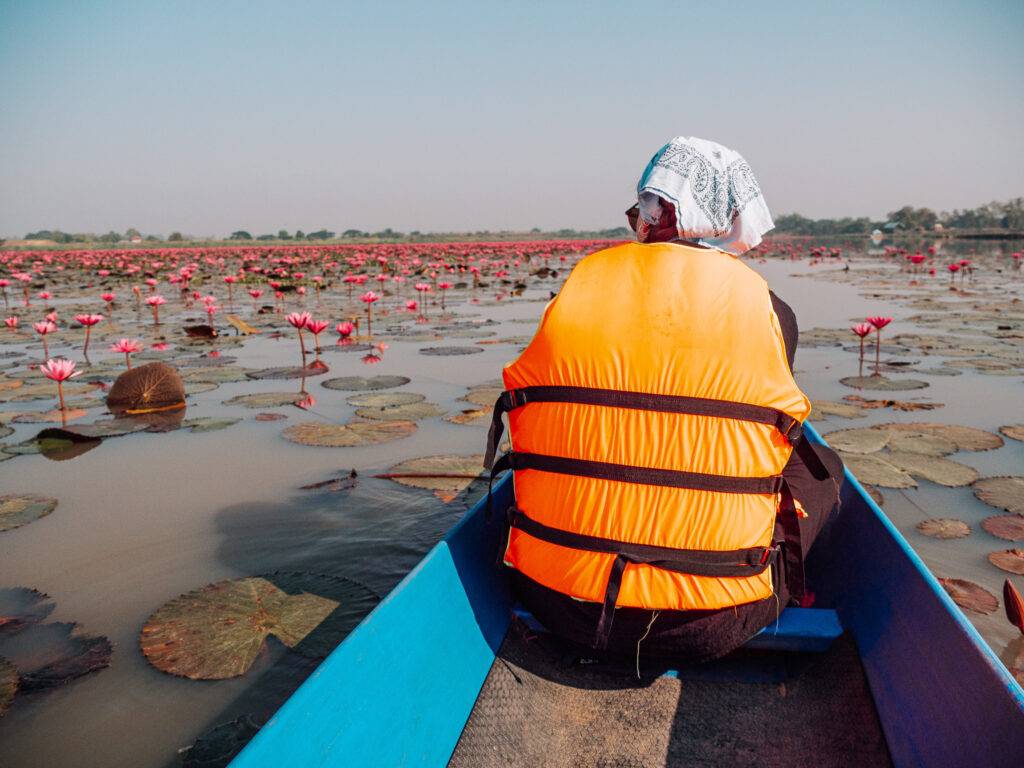
Sala Keoku
My partner’s favorite, Sala Keoku is a park of monumental sculptures straight out of the imagination of an artist named Bunleua Sulilat. The place houses a hundred concrete statues representing figures from Buddhism and Hinduism, some of which reach up to 25 meters high!
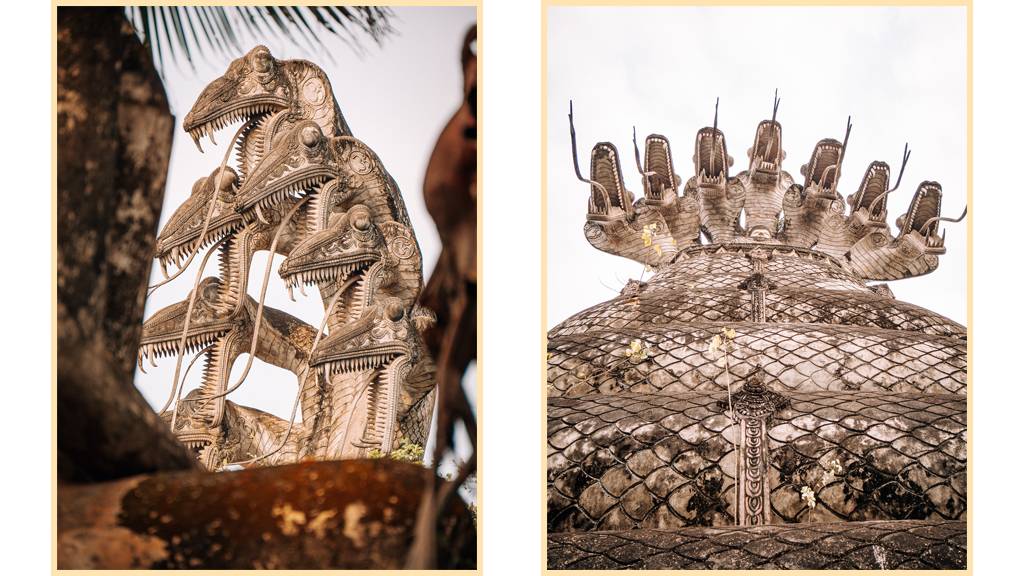
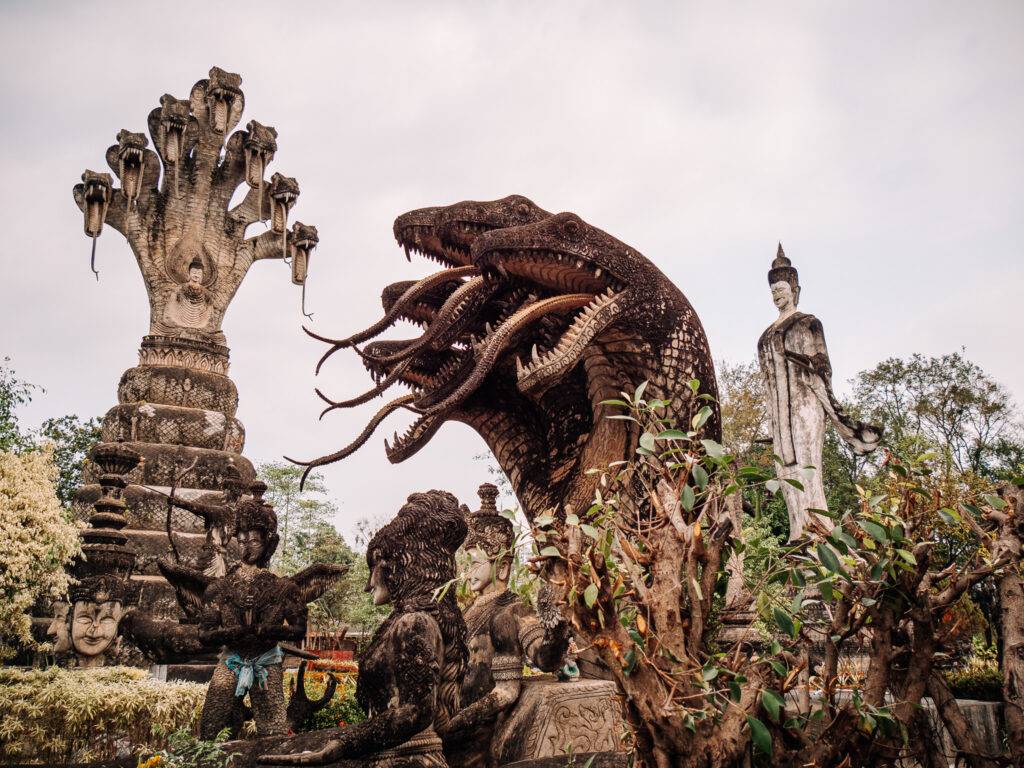
Admission costs 40 baht (about €1.10) per person, and the park is only a few miles from downtown. You can easily get there by Grab (the equivalent of Uber in Thailand) or local bus, without any worries.
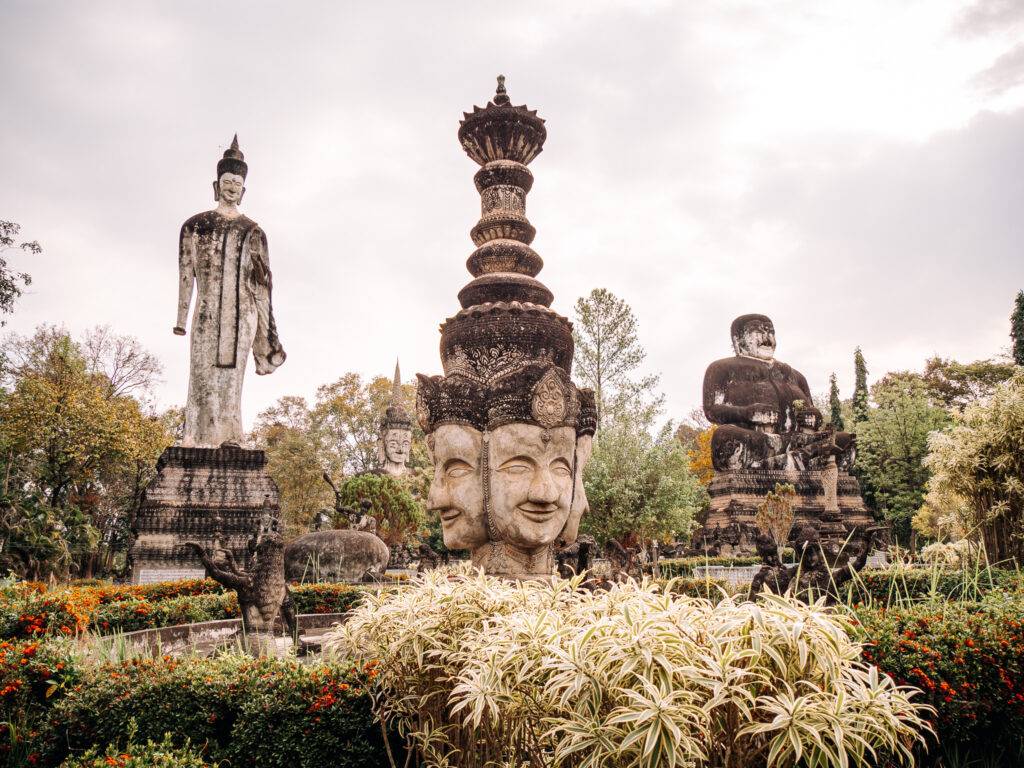
Where to sleep and eat in Nong Khai?
For the moment, I will not recommend our accommodation in Nong Khai: we clearly made a mistake in our choice, and it was really not terrible. That said, after talking to a few travellers, two establishments came back with good feedback: Mut Mee Garden Guesthouse or The MACEO Hotel.
If you’re looking for good places to eat in Nong Khai, here are two that we really enjoyed:
- Maruaypawdee Vegetarian Restaurant: A vegetarian buffet at a very low price, with local cuisine full of flavors. Simple, authentic, and perfect for healthy eating without breaking the bank.
- Macky’s Riverside Kitchen: A quality cuisine in a very pleasant setting, just on the edge of the Mekong.
How to get to Nong Khai?
- By car or taxi: Usually a public transport enthusiast, this time we opted for a taxi or private driver. We came from Chiang Khan and, Isan obliges, there was very little information available on this route. So we made it simple: we met a driver in town, who took us to Nong Khai in about 2h30 drive. From Bangkok, there are buses that reach Nong Khai in about 10 hours.
- By train: From Bangkok, trains and night trains run to Nong Khai every day for about 11 hours.
➡️ Book your train or bus tickets online
Visiting the Isan region in northeastern Thailand
We now descend to the south-east of the Isan, towards Ubon Ratchathani. It is a true cultural crossroads of Southeast Asia, strongly influenced by the Thai, Laotian and Khmer cultures, Cambodia being not very far. If you like original temples filled with gilding, this city is a small paradise of Thai know-how in this area!
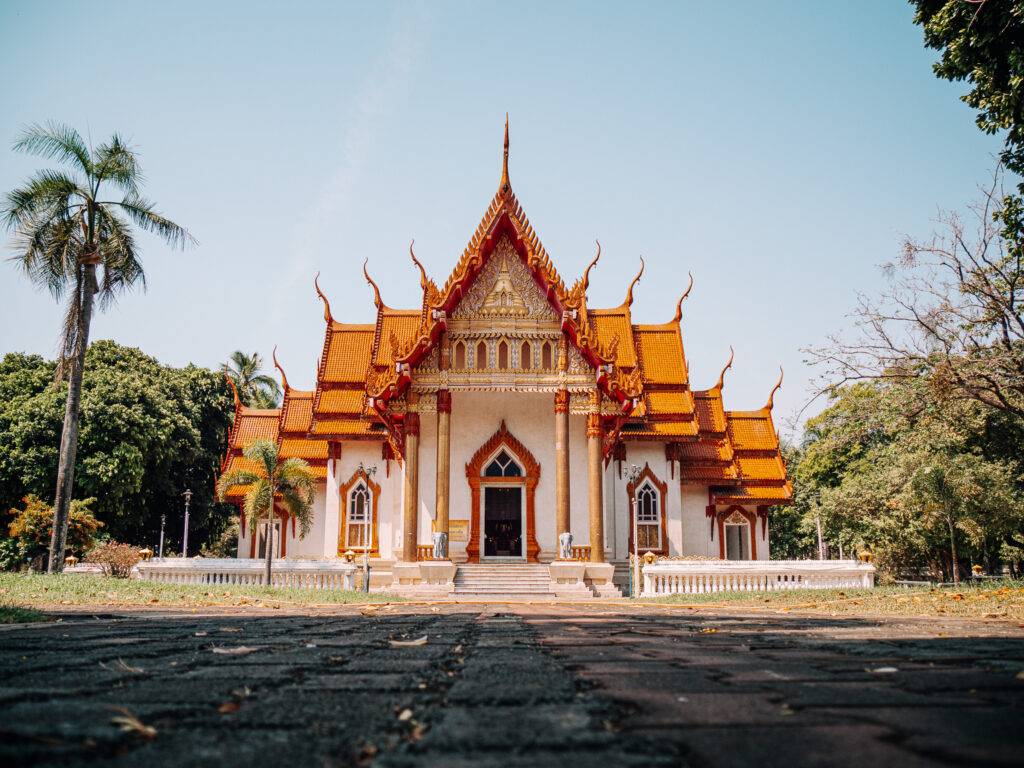
What to do in Ubon Ratchathani?
Wat Phra That Nong Bua
This temple is one of the most emblematic of Ubon Ratchathani and even of the whole region. Built in 1956 to celebrate 2,500 years of Buddhism, it is a strong symbol in Thailand. Its architecture is unique in the country, with a huge white and gold stupa of 56 meters high, surrounded by many statues of Buddha spread throughout the four corners of the temple and complex. When you’re at the bottom of it, you feel really small!
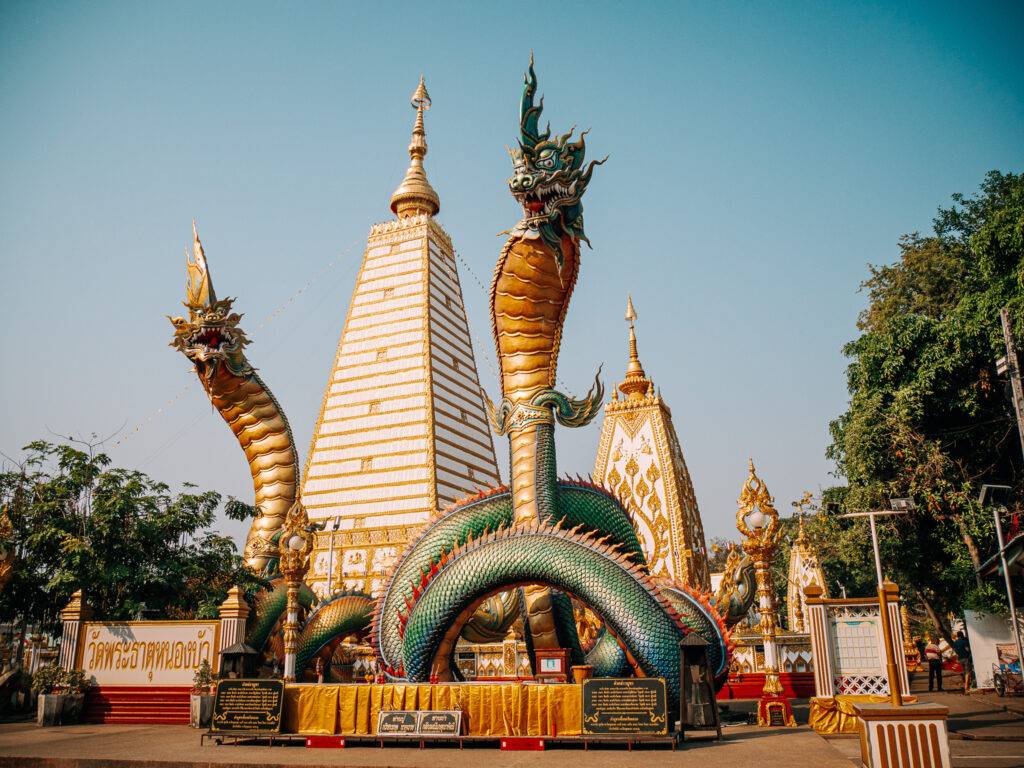
It is located north of the city center, very accessible on foot if you like to walk and do as we a small tour of visiting the temples of the city. Otherwise, it is easy to get there by Grab or taxi, which can be found everywhere in the city. This is personally one of the temples I preferred to visit in thailand, beyond the stupa there are plenty of other pagodas around that are well worth visiting!
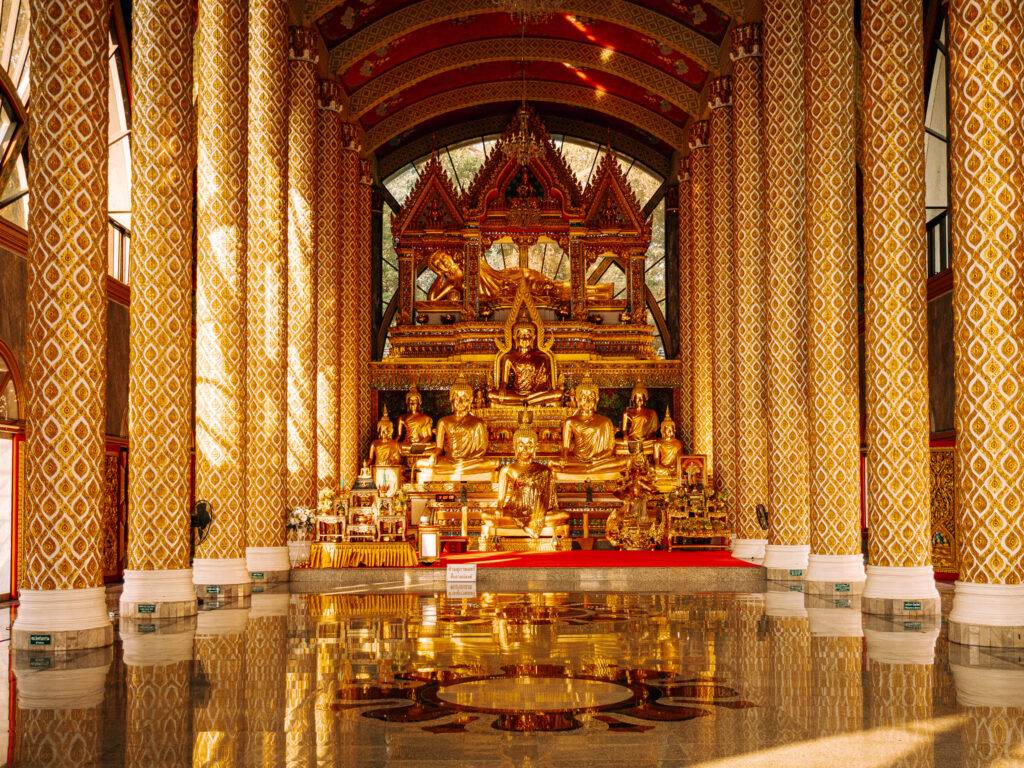
Wat Tai Phrachao Yai Ong Tue
Less touristy than other sites in the city, this complex is known to house one of the largest seated Buddha statues in the Isan region. But honestly, what strikes first when you enter it is especially this pile of statues, pagodas and altars arranged absolutely everywhere, from the ground up. There are in every corner, which creates a kind of small spiritual labyrinth to go through to discover the main pagodas. We really loved walking there!
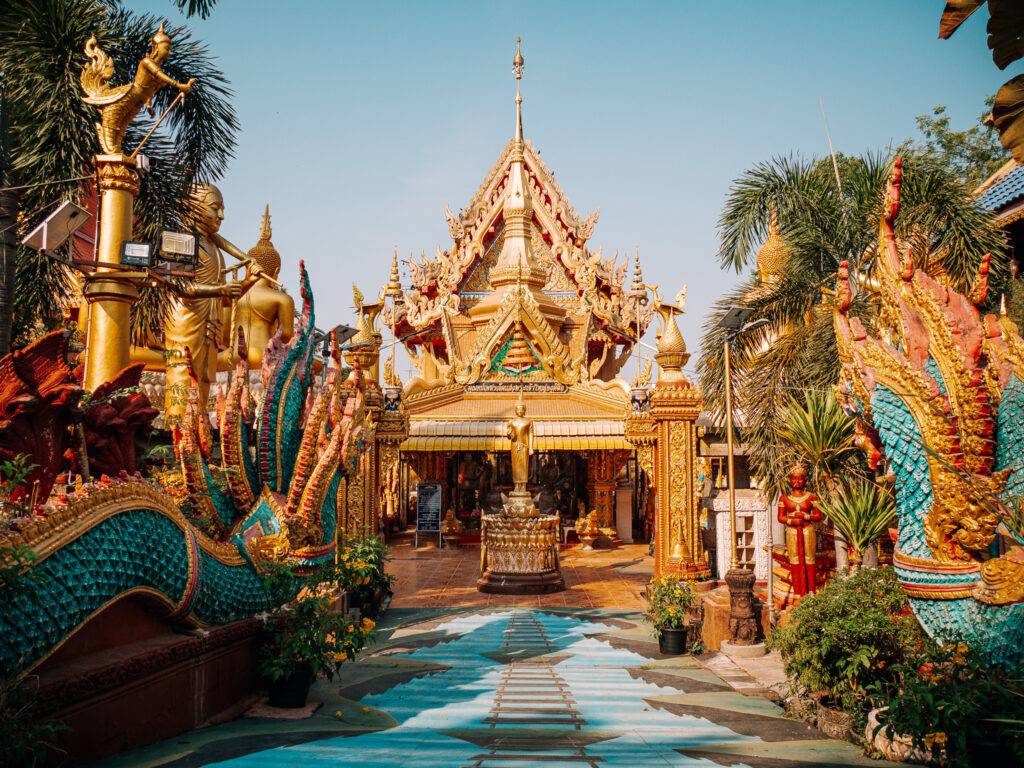
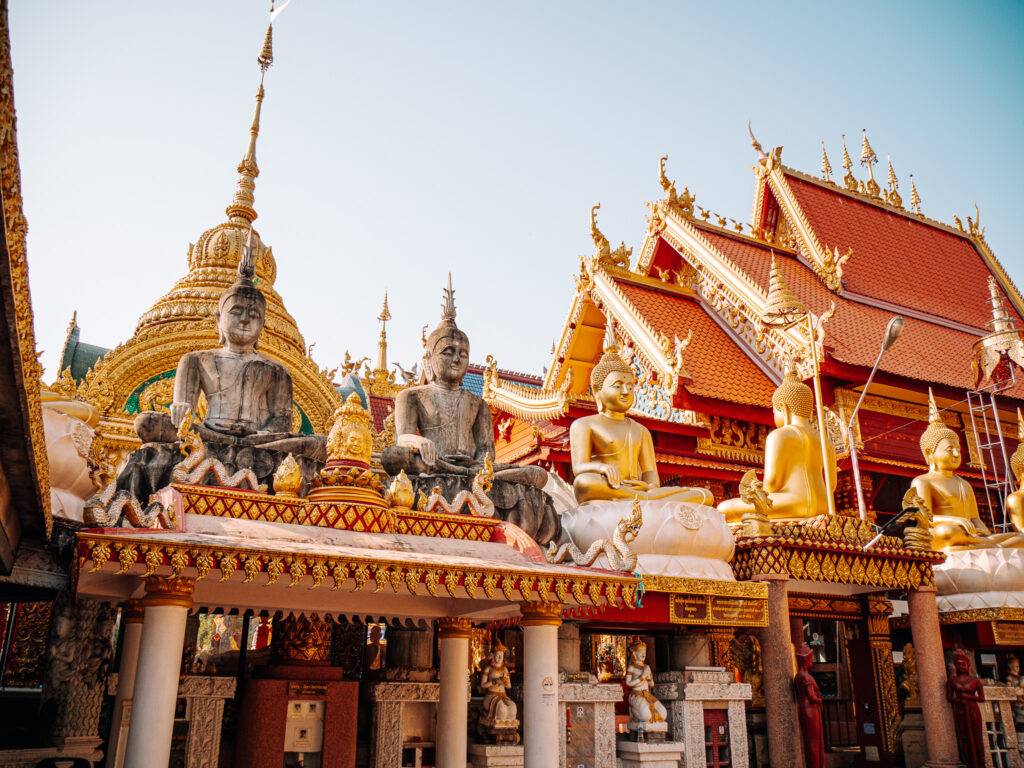
Wat Maha Wanaram
Probably the most visited temple in the city centre, Wat Maha Wanaram dates from 1779 and houses one of the most sacred Buddha statues in the country, entirely covered with gold leaf. We enjoyed admiring the exterior engravings depicting certain passages of the life of Buddha. If you are there during a Buddhist festival, you will have the opportunity to attend many animations: locals from all over the region often meet here to feast!

Where to sleep and eat in Ubon Ratchathani?
For housing, we chose the Eco Inn Lite. The hotel is not very well rated on Booking, I do not know why, because during our stay everything went very well. Standard comfort, ideally located and clean. A bit like an ibis in France. The price is also very correct. He does the bare minimum, but he does it well!
We loved to eat and drink along the Mun River at:
-
-
- Snack sho coffee: As the name suggests it’s a small snack but the place is very cute and the staff really very nice.
- Nuehom Restaurant: Located right next to the snack bar, it’s a great place to discover some local specialties. Be careful, there are a lot of locals at meal times, so remember to come early!
-
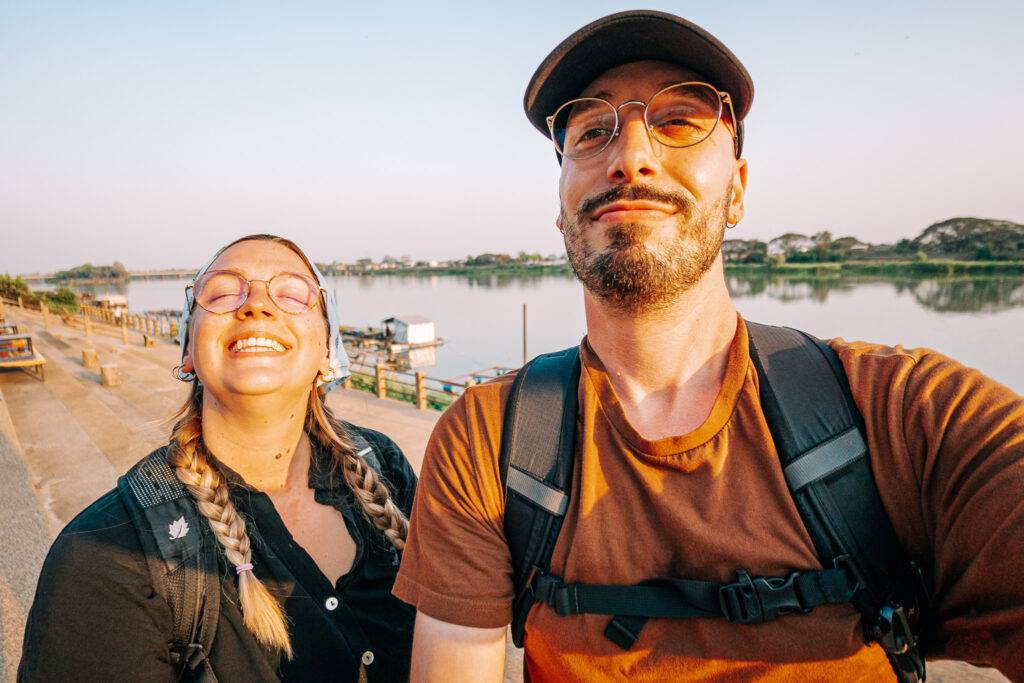
How to get to Ubon Ratchathani?
- By bus: We were leaving from Khon Kaen, a town west of Ubon. No problem to find a bus at the bus station, the trip took about 3-4 hours. There are also buses from Bangkok that take about 9-10 hours.
- By train: There is no direct train from Khon Kaen, so you may prefer to take the bus. From Bangkok, on the other hand, there are daily connections from Hua Lamphong station. The journey usually takes 10-11 hours, and night trains also operate.
➡️ Book your transport tickets online
Off the beaten track in Thailand
Last destination of this route in Northern Thailand and probably the least touristy place of this guide: Khong Chiam! Located in the extreme east of Thailand, this village is ideally located, offering a superb setting along the Mekong River with several interesting activities to discover. It is also very close to Laos, making it a perfect starting point if you want to continue your trip there after Thailand.
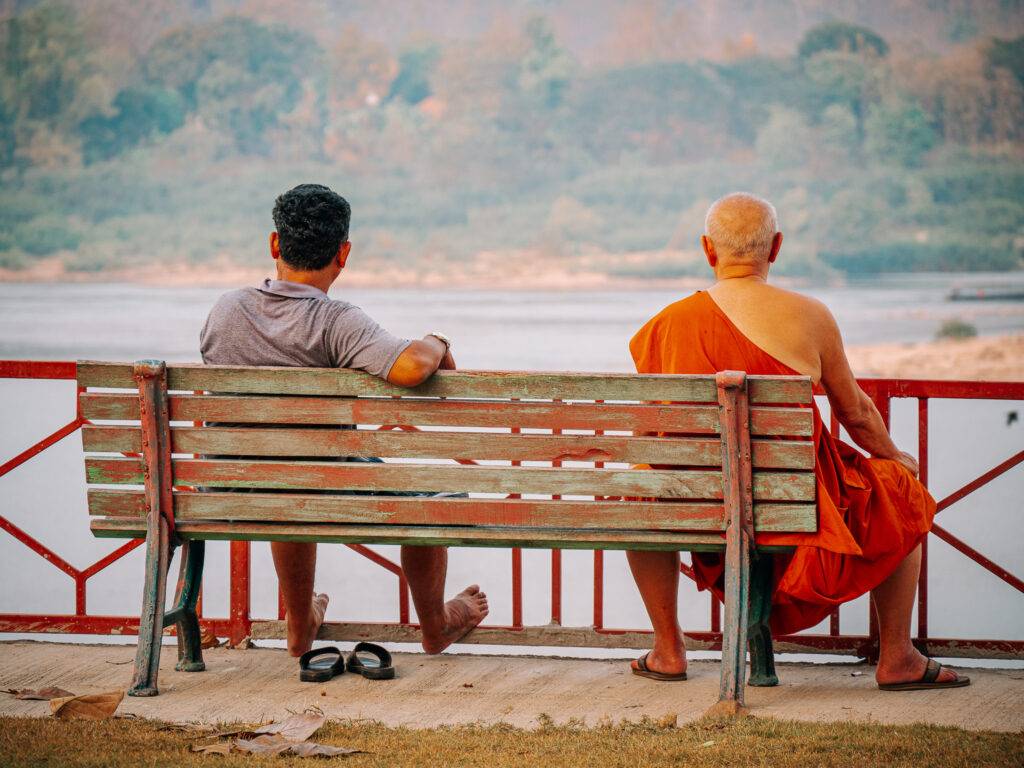
What to do in Khong Chiam?
✨ Two color river point
To the east of the village is Thailand’s easternmost point, called “Two Color River Point”. This is where the Mekong River and Mun River meet, creating a natural phenomenon that locals call “Mae Nam Song Sii”. Especially visible during the dry season, we distinguish very clearly the two currents with different colors that do not mix immediately, it is really beautiful to see!
The viewpoint is at Wat Khong Chiam, the village’s great pagoda. At sunset, the view of Laos and the confluence of rivers is just magical!
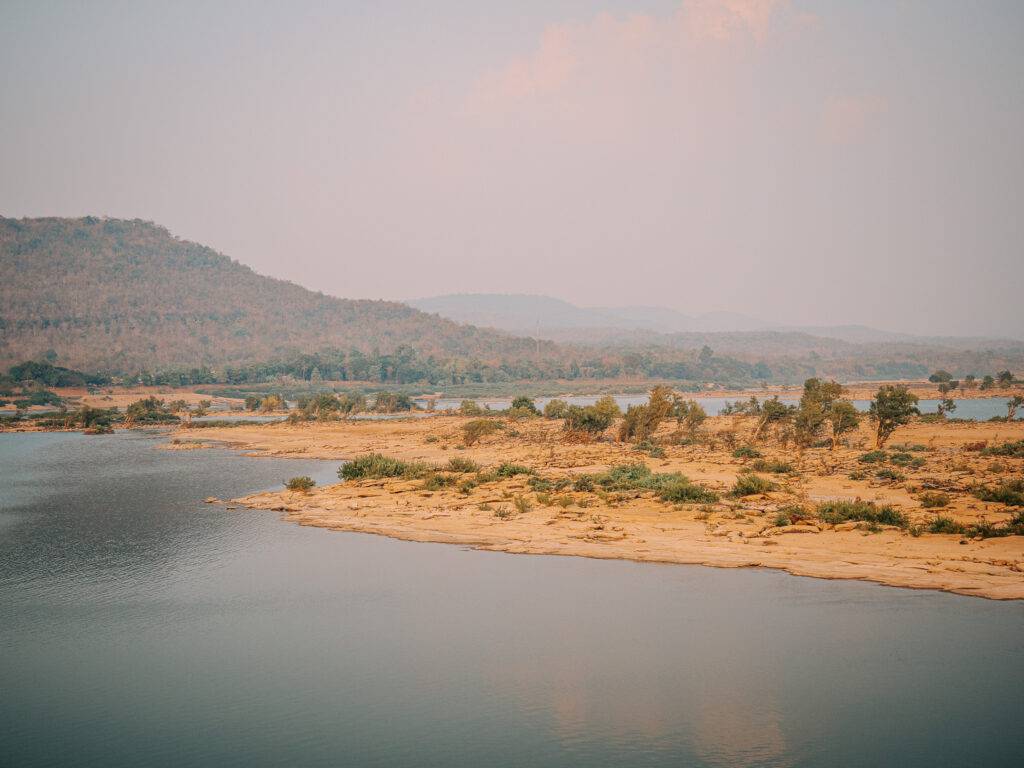
✨ Kaeng Tana National Park
This national park is perfect for hiking! Located a little fifteen kilometers from Khong Chiam, it is very little frequented, wrongly if you want my opinion. There are all kinds of animals in the middle of the forest, jungle and hills. The Mun river runs through the park and creates a kind of small oasis in the middle of nature: it is really a super nice place to explore! Fun fact: the park is also home to the longest pedestrian bridge in the country, which you can of course cross without any risk!
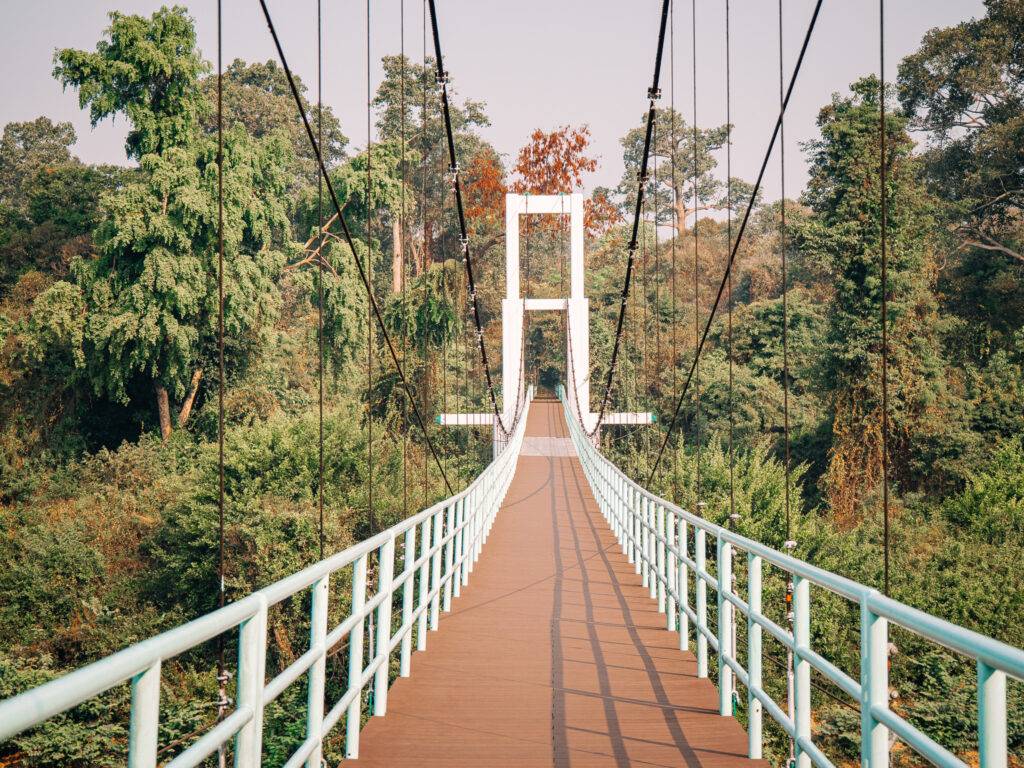
The entrance to the park costs 100 baht per person (about 2.80€), and if you go hiking all day, you can reach several viewpoints that offer magnificent panoramas of the region.
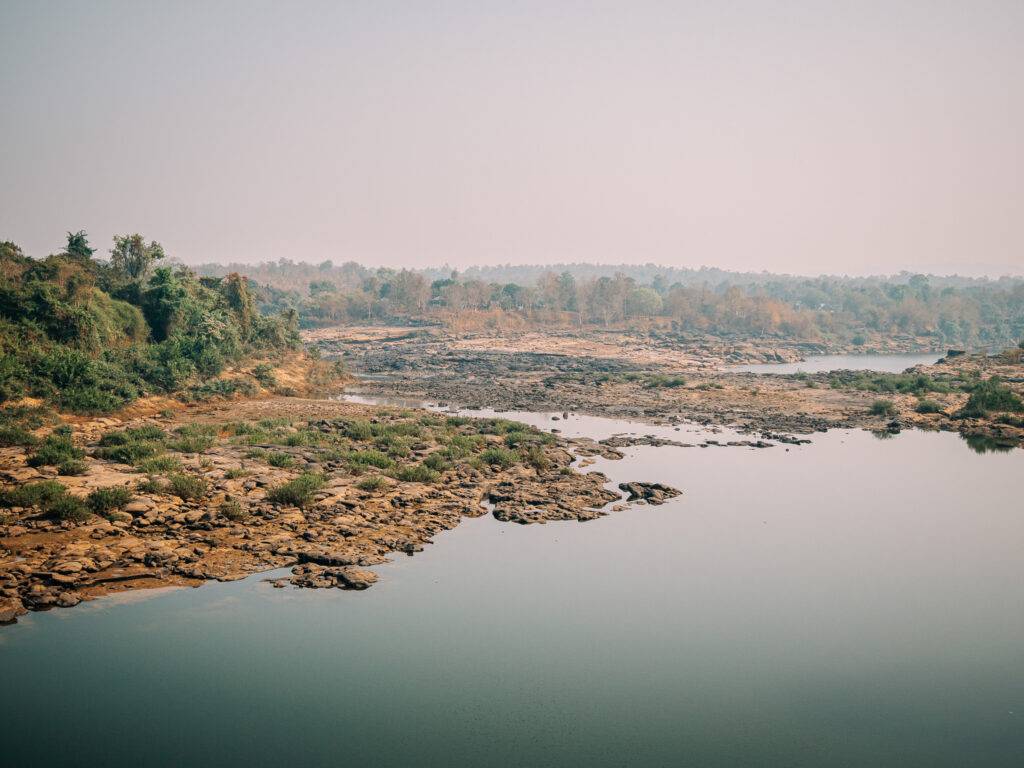
✨ Pha Taem National Park
It is probably the national park that offers the best view of Laos, its neighbour! The entrance costs 200 baht per person (about 5.40€) and gives you access to the whole area.
In the first part of the park, you will walk along a large cliff, the site is particularly known for its prehistoric paintings, similar to those of Lascaux. Along the cliff, you can admire these works created by our ancestors several thousand years ago. Then, we climb the famous cliff (the path is very well marked and easy to access) to enjoy a breathtaking view of Laos and the Mekong.
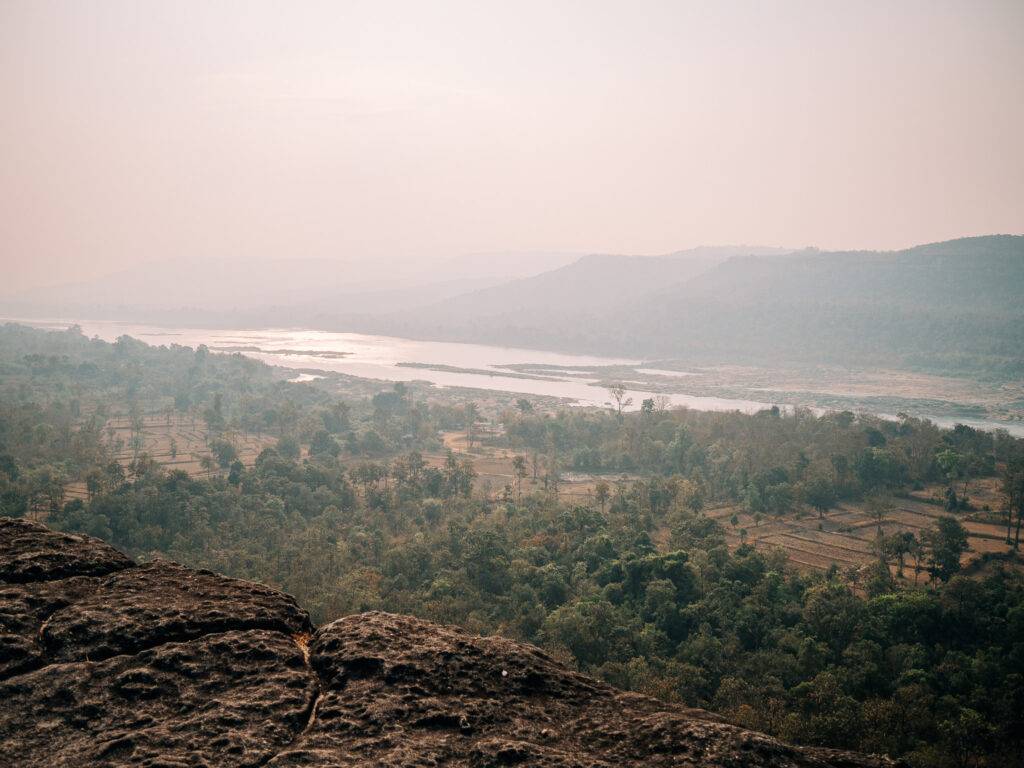
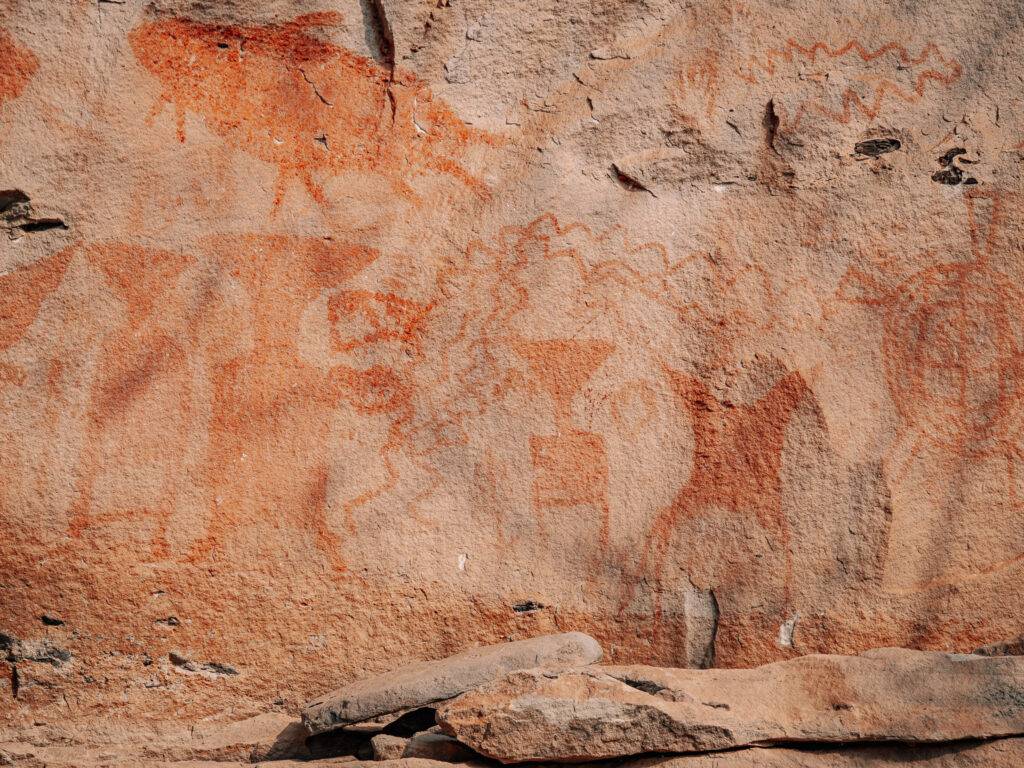
You can also go canoeing, visit beautiful waterfalls and eat near the ticket point. Personally, I loved this place because there are a multitude of activities to do. However, do not forget to protect yourself from the sun, because once at the top, the shade is scarce!
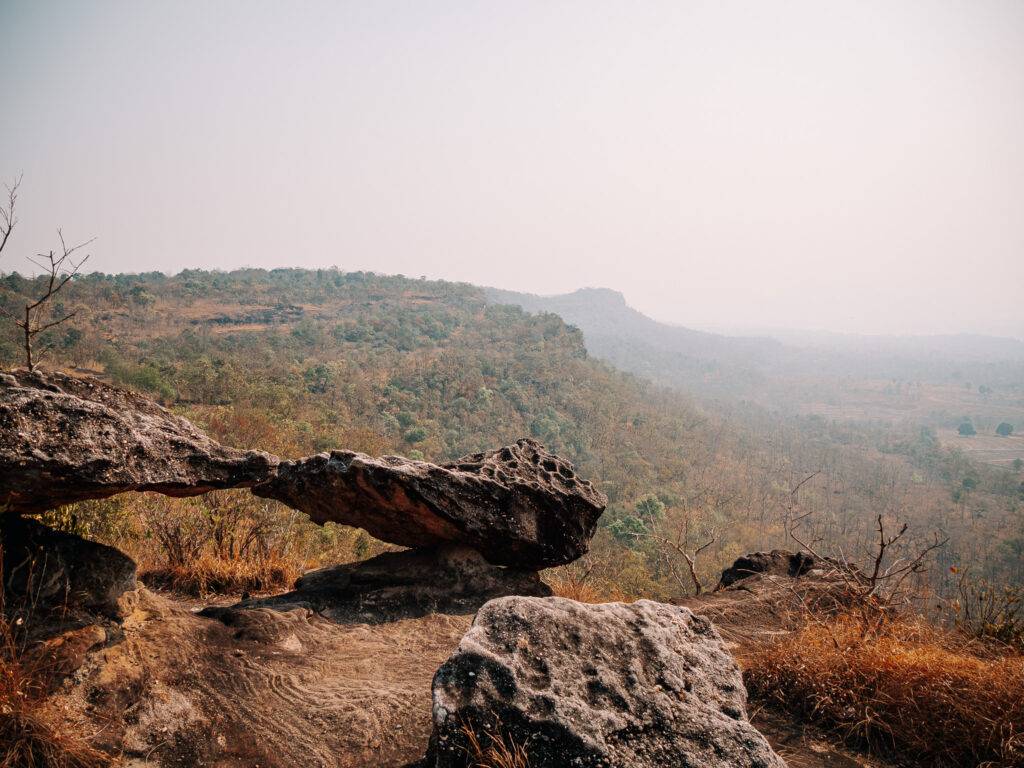
Wat Tham Khuha Sawan
Back in a Buddhist complex, this one is known to house one of the largest gong in the world, with its diameter of 20 meters that can be seen from the surroundings. It was built to celebrate ASEAN (the equivalent of the European Union in Asia). There are also several pagodas including one that is reminiscent of the beautiful white temple of Chiang Rai! A few steps from Khong Chiam are perfect for a late-day visit.
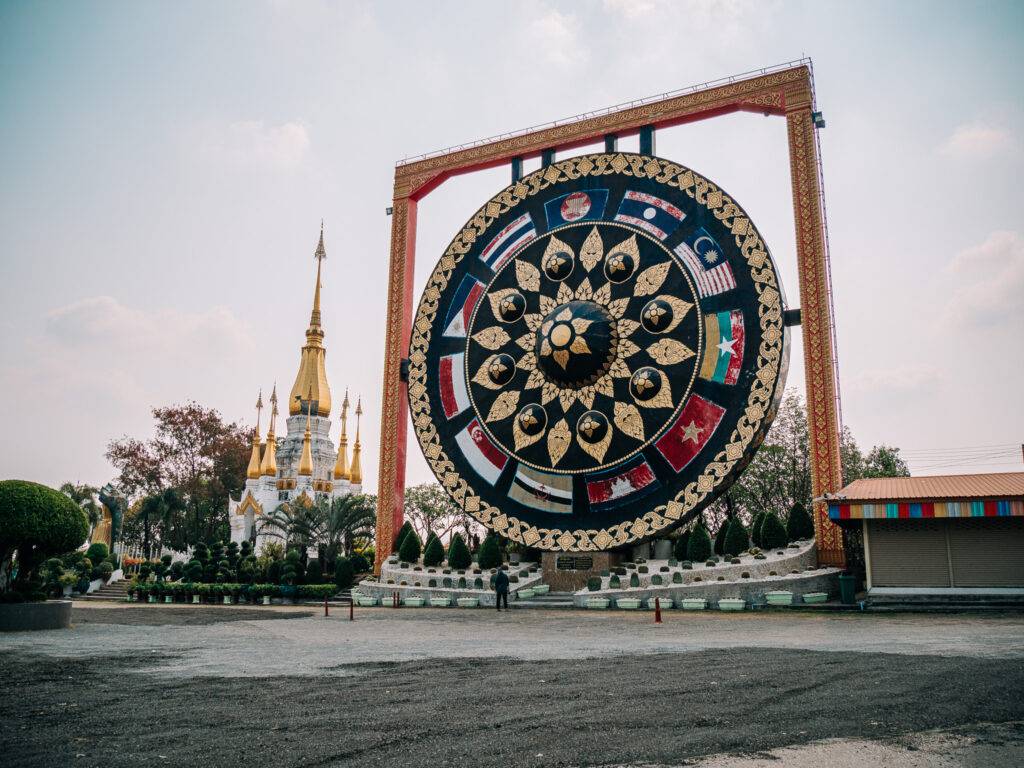
Wat Tham Heo Sin Chai
If you have an adventurous soul and like places worthy of a film set, you are in the right place! Not far from Khong Chiam is this sanctuary carved out of the rock, forming a natural vault that houses many Buddhist statues. The access is not easy, but a few wooden panels will lead you on a somewhat steep trail… until the magic works. It is a place still very little frequented, you may have the chance, like us, to have it entirely for yourself!
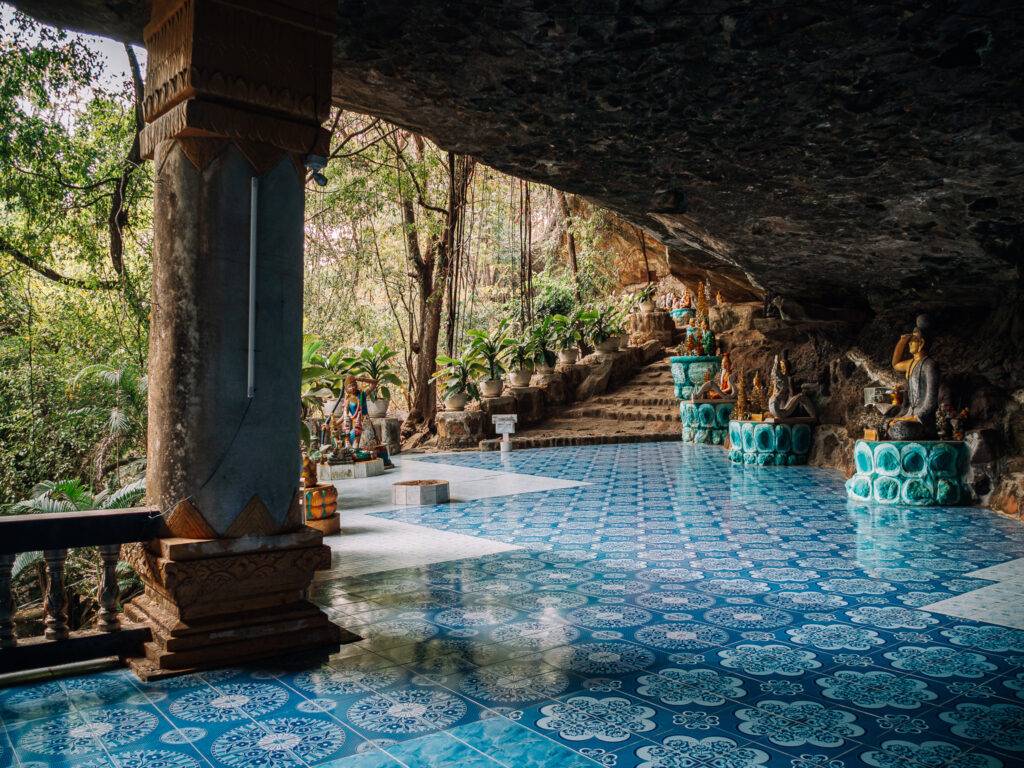
We were in the dry season, so no waterfall that day. Too bad, because during the rainy season, a large waterfall gushes from the top of the vault to throw itself lower in the river, we saw some videos and photos online, it’s really spectacular! The site is regularly maintained by monks, so as for any sacred place, remember to respect the customs: remove your shoes and hat, and cover your shoulders and legs.
Where to sleep and eat in Khong Chiam?
Our accommodation in Khong Chiam was a very good surprise. Tourism is not yet very developed in the area, the offer is quite limited, but it ticks all the boxes. This is the Baan Kieng Tawan: modern, comfortable and clean rooms, scooter rental directly on site, and especially a very welcoming manager. It felt really good!
Eating, on the other hand, is a bit more complicated. The “problem”, if we can call it that, is that the village is therefore very little touristy: suddenly, most restaurants and small cafes close very early, especially on weekdays. From 6pm, everything is often closed… As you can say that we were surprised the first nights. Fortunately, there is a 7-Eleven in the center, which saved us a lot! During the day, you will still find several small restaurants and nice bars along the Mekong, north of the village. They are not necessarily on Google Maps, but when you walk around, you will see several!
How to get to Khong Chiam?
By bus/minivan: From the Ubon Ratchathani bus station (Terminal 2), there are a few departures in the morning to Khong Chiam. The trip takes about 1h30 and costs 80 baht per person (about 2.20€). If you are leaving from Bangkok, you will first have to reach Ubon, either by bus or train (see above), then take a minivan to Khong Chiam as explained above.
That’s it for this guide to the North and Isan region of Thailand. A big thank you to Aurélie and Yann for allowing me to share these lines on their beautiful blog! I hope that this has made you want to discover another side of Thailand, or just esc

Adepte du slow travel, je ne vois pas le voyage comme une simple liste à cocher. J’aime prendre le temps de m’immerger dans un pays, de m’imprégner de sa culture et de son essence. J’ai récemment passé plus d’un an en Asie du Sud-Est avec ma compagne, notre plus belle aventure à ce jour ! En parallèle du voyage, je suis professionnel de la communication, spécialisé en graphisme, photographie et montage vidéo.





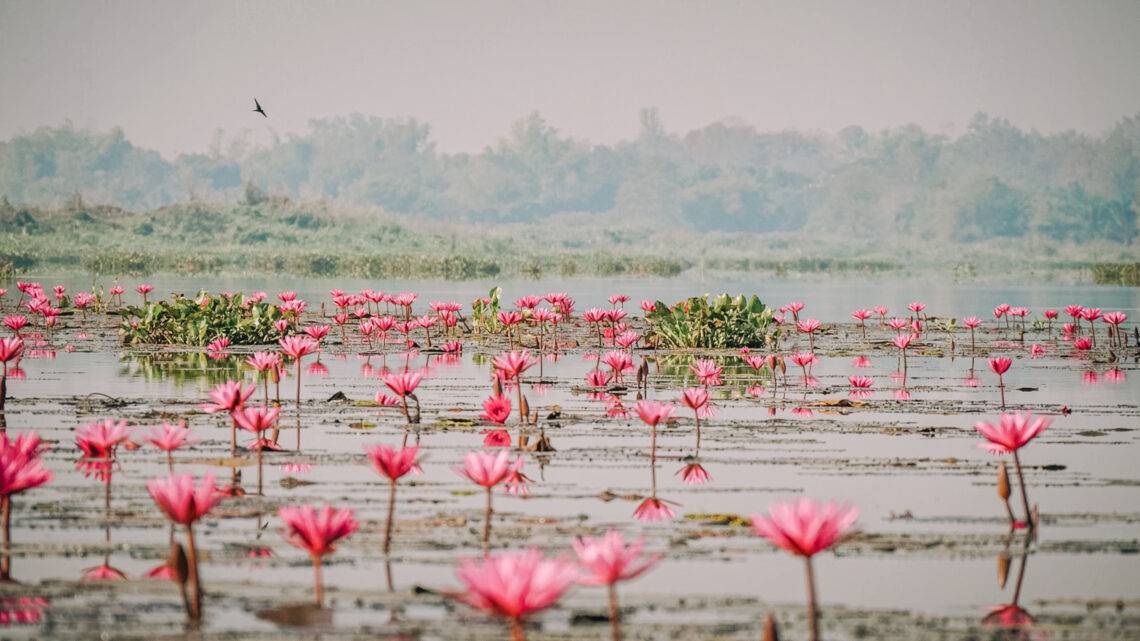

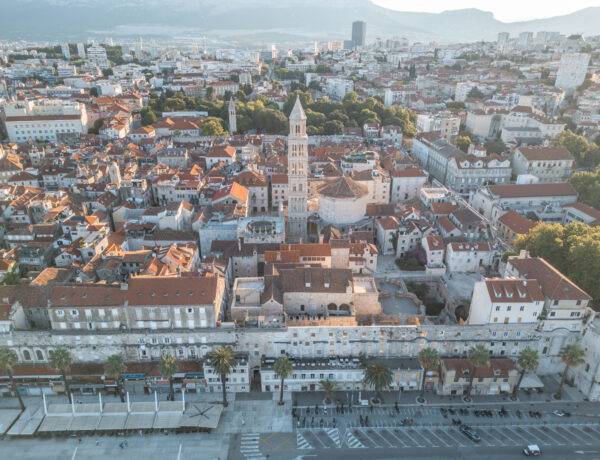
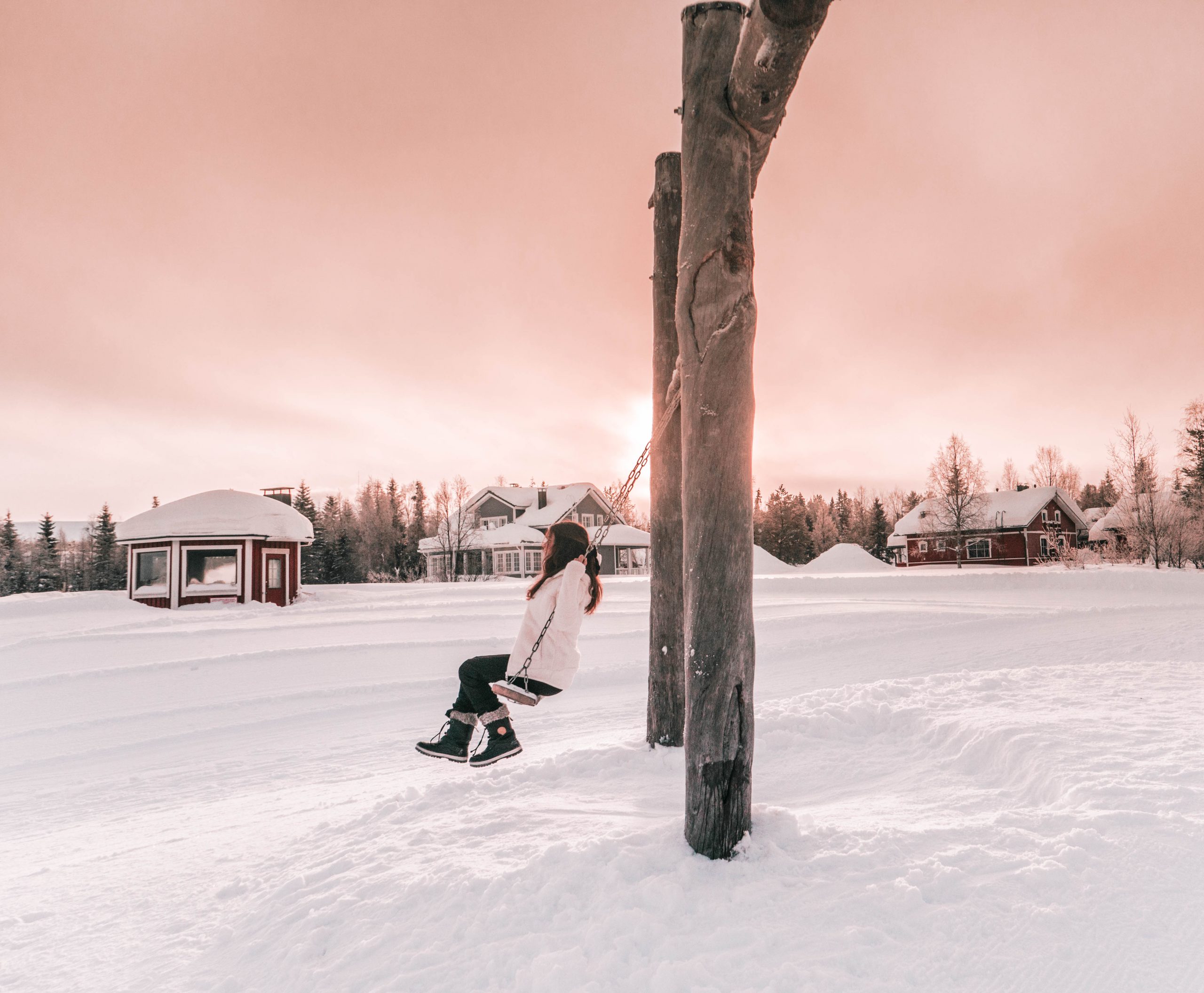
No Comments